
1 | P a g e
Air Monitoring at T.F. Green Airport
July 2020 – June 2021 Annual Report
June 2022

2 | P a g e
Table of Contents
Introduction…………………………………………………………………………………………………………………… 3
Monitoring Strategy………………………………………………………………………………………………………. 4
Background……………………………………………………………………………………………………………………. 6
Environmental and Temporal Effects………………………………….…………………………………………. 8
Particle Count Results.………………………………………………………………………………………………….. 15
Black Carbon Results…………………………………………………………………………………………………….. 25
Correlations between the Collected Data……………………………………………………..……….……… 33
Comparison to Results from Elsewhere in the State …………………………………………………….. 34
Findings and Recommendations…………………………………………………………………………………… 37

3 | P a g e
Introduction
Chapter 1-7 of the Rhode Island General Laws, the Permanent Air Quality Monitoring Act (the
Act), requires the Rhode Island Airport Corporation (RIAC) to conduct long-term air monitoring
at four sites located near T.F. Green Airport to determine the impact of “air pollutants, which
may be harmful to public health” on the “densely populated, primarily residential area of the
city of Warwick” that surrounds the airport. § 1-7-1 of the Act required RIAC to monitor particle
count, as an estimate of ultrafine particles, and black carbon.
RIAC began monitoring for these pollutants in early 2008 using procedures and specifications
outlined in a workplan developed in consultation with the Rhode Island Department of
Environmental Management (DEM) and the Rhode Island Department of Health (RIDOH), as
required in § 1-7-1. After consultation with RIDOH and DEM, RIAC has amended the workplan in
subsequent years, and those amendments include changes in the location of the monitoring
site east of the airport, moving a monitoring site south of extended Runway 5-23, and an
elimination in the monitoring of certain pollutants. The current legislation expires July 31, 2024.
The 2017 legislation also requires RIDOH to prepare an annual report which shall contain a
summary of the data collected from the monitors, the department's findings, analysis,
conclusions, and recommendations resulting from the data generated by and from the
permanent air quality monitors (“the monitors”). This document shall serve as the fifth annual
report. Inquiries about this report and its contents can be directed to Michael C. Byrns, PhD,
Environmental Health Risk Assessment Toxicologist Center for Healthy Homes and Environment
Rhode Island Department of Health (contact information below).
Michael C. Byrns, PhD
Environmental Health Risk Assessment Toxicologist
Center for Healthy Homes and Environment
Rhode Island Department of Health
3 Capitol Hill, Providence, RI 02908
401-222-7766

4 | P a g e
Monitoring Strategy
Monitoring procedures used to measure the pollutants identified in § 1-7-1 of the Act following
the 2017 amendments use continuous monitors, which are electronic devices that record the
pollutant level on regular time intervals, to measure ultrafine particles (particles smaller than
0.1 microns, estimated as particle count) and black carbon (an indicator of pollution as a result
of combustion). RIAC monitors in accordance with the Air Quality Monitoring Work Plan (800-
RICR-10-00-3) last amended in November 2019 and a Quality Assurance Project Plan approved
in 2008.
Prior to the 2017 amendments to the Act, monitors were placed at cardinal directions (one
north, south, east, and west) in relation to the airport. Two monitoring stations, Lydick and
Field View, remain in their original location. The Pembroke station has been relocated twice,
once to accommodate the relocation of the Winslow Park athletic fields and again after
construction of the athletic fields was completed. The current site was selected by residents
and is near its original location east of the airport. The monitoring station previously located at
the Fire Station, which was west of the airport, was moved to a new location on Smith Street,
south of the extended runway, in the second quarter of 2020 to accommodate the amended
law’s requirement that monitors be designed to measure the impact of the extended runway.
See Figure 1 for locations. Further site-specific details are listed below.
• The Lydick site (north of the airport) is on Lydick Avenue in the Hoxsie section of
Warwick, about 0.5 miles northeast of the northeast (23) end of the main runway. The
area around this monitor is a residential neighborhood, and the closest residence is
approximately 25 yards from the monitor.
• The Field View site (south of the airport) is located on Field View Drive less than 0.1
miles west of the taxiway to the main runway (runway 5-23). Flights taking off on
runway 5 (to the northeast) idle in line in the section of the taxiway near the monitoring
site while waiting for clearance, and then they turn a corner and enter the runway to
begin take off. The site is 0.1 - 0.2 miles south of airport parking areas. For the 2005-
2006 monitoring study, the Field View monitoring shelter was in the yard of an occupied
home, but RIAC has since purchased and removed that and neighboring homes. The
closest residence is approximately 220 yards from the site.
• The Pembroke site was originally located just east of the airport on Pembroke Avenue,
which was the street closest to that side of the airport. At that time, occupied
residences were located adjacent to the site. Those homes and residences on the next
parallel street, Gayton Avenue, have been purchased and removed by RIAC. Winslow
Park, which was then located south of the airport, was moved to the Pembroke Avenue
area to make room for the southern extension of the main runway. Since June 2015, the
station has been in its current location, which is off Rowe Avenue on the side of
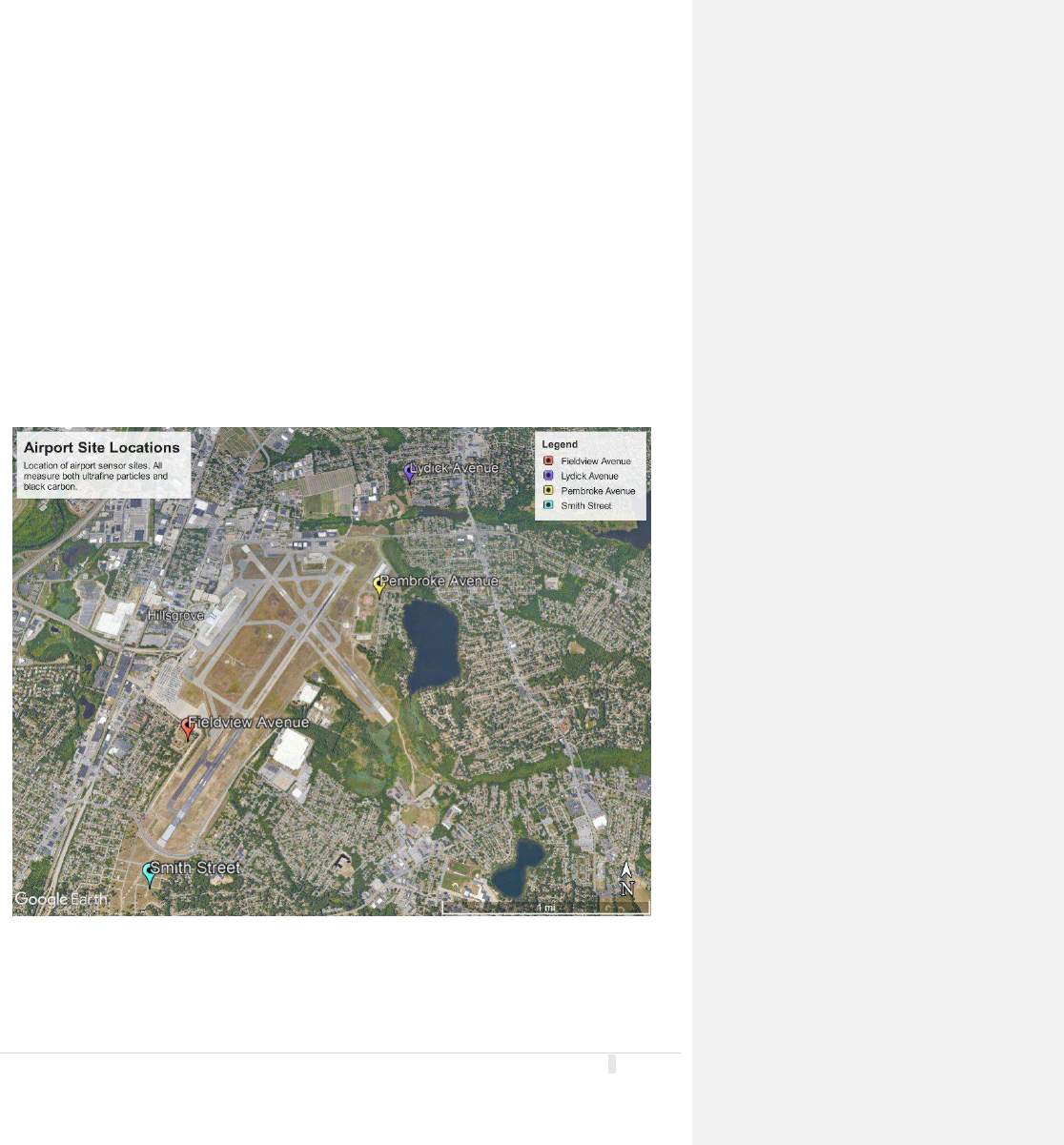
5 | P a g e
Winslow Park most distant from the airport and adjacent to the closest residences on
Wilber Ave. This location was selected by a group of residents, agreed to by RIDOH and
DEM, and codified through a workplan amendment.
• The site currently located at Smith Street near Greenlawn was previously located at the
Fire Station site. This station was previously located behind Fire Station #8,
approximately 0.25 miles northwest of the end of the airport’s secondary runway.
RIDOH and DEM determined that data collected at the Fire Station site seemed to
indicate that the pollution levels measured at the location were more heavily affected
by non-airport sources rather than those associated with the airport. § 1-7-1 was
amended in 2017 to require a monitoring station south of the extended runway. The
monitoring station was taken offline for repairs and recalibration on December 4, 2019.
The station was moved to the Smith location and was brought back online on April 24,
2020.
Figure 1: Locations of Air Quality Monitoring Sites

6 | P a g e
1
Kwon, HS., Ryu, M.H. & Carlsten, C. Ultrafine particles: unique physicochemical properties relevant to health
and disease. Exp Mol Med 52, 318–328 (2020). https://doi.org/10.1038/s12276-020-0405-1
2
Ostro, B et. al, “Associations of Mortality with Long-Term Exposures to Fine and Ultrafine Particles, Species
and Sources: Results from the California Teachers Study Cohort,” Environmental Health Perspectives 123(6),
June 2015.
Background
During the current year, both ultrafine particles, measured as particle count, and black carbon,
measured in nanograms per cubic meter (ng/cm
3
), were taken in one-minute intervals. This
changed from previous years when particle count was measured in 10 second intervals and
greatly reduces the volume of measurements taken, allowing for easier data processing and
analysis. There is no loss in useable data from this change because the 10 second interval data
was too variable to use without averaging it by minute. For the current analysis, both particle
count and black carbon levels were averaged into one day intervals and compared against the
daily weather data. A daily timeframe was chosen because health data are available on a daily
timeframe. Though not included in this report, future analyses may examine any correlation
between health outcomes in nearby communities and air pollution levels.
Ultrafine particles, particles less than 100 nanometers (nm) in diameter, are associated with
cardiovascular disease and other health concerns and may be more toxic than more commonly
measured larger particles, such as fine particles less than 2.5 micrometers (PM
2.5
). Ultrafine
particles are primarily emitted by combustion. Their concentration is elevated near pollution
sources and decreases quickly with time and distance, due to dispersal and a combination of
evaporation of small particles and condensation onto larger particles. These processes increase
particle size while reducing particle count. Ultrafine particles are thus representative of local
pollution sources and not suitable for evaluating regional pollution. Because of the variability in
their level over short distances, it isn’t feasible to establish standards for levels of ultrafine
particles and it has been challenging to evaluate the associated health effects. However, they
are also easier to associate with specific sources. The measurement of ultrafine particles in the
current study provides an opportunity to better understand the conditions leading to their
production and may allow future investigations into associated health effects.
Although it is difficult to distinguish the effects of ultrafine particles from other pollutants that
they typically cooccur with, there is increasing evidence to suggest that short-term ultrafine
particle exposure causes respiratory and cardiovascular health effects. Toxic substances tend to
be concentrated on ultrafine particles and more bioavailable, and thus may be more likely to
cause toxicity than larger particles.
1
Due to their very small size, ultrafine particles, when
inhaled, can travel deep into the respiratory tract and pass across membranes in the body that
would block the movement of larger particles. A 2015 study by the California EPA demonstrated
that long-term exposure to ultrafine particles contributes to heart disease mortality. Certain
constituents of ultrafine particles, including copper, iron, other metal, and elemental carbon
(soot) were strongly associated with death from heart attacks.
2

7 | P a g e
3
M, Redaelli; M, Sanchez; E, Fuertes; M, Blanchard; J, Mullot; A, Baeza-Squiban; G, Garçon; C, Léger; B,
Jacquemin, Health effects of ambient black carbon and ultrafine particles: review and integration of the
epidemiological evidence, Environmental Epidemiology: October 2019 - Volume 3 - Issue - p 347-348 doi:
10.1097/01.EE9.0000609832.55044.74
4
RIDEM, Characterization of Ambient Air Toxics in Neighborhoods Abutting T.F. Green Airport and
Comparison Sites, April 2008.
Black carbon is also measured continuously at the airport sites. It is formed as a result of
incomplete combustion of fuels and is therefore used as an indicator of vehicle exhaust. Health
effects of black carbon exposure include negative effects in respiratory and cardiovascular
health, a positive correlation with all-cause hospitalizations, as well as an increase in all-cause
mortality from long-term black carbon exposure.
3
There is not a standard for black carbon, but
it is the combustion component of PM
2.5
. PM
2.5
has a National Ambient Air Quality Standard,
which was not exceeded in previous monitoring around the airport. Because there appears to
be more variability in black carbon levels as a result of activities in and around the airport than
PM
2.5
, black carbon measurement has continued after monitoring of other pollutants stopped
following the 2017 amendments to the Act. During a previous 2005-2006 study
4
, black carbon
levels at the sensors near the airport were higher when the wind was blowing from the airport
than when it was blowing away from the airport. For this reason, black carbon levels have
continued to be measured after PM
2.5
and other pollutants from the original Act were
discontinued.
DEM and RIDOH routinely measure black carbon levels at three sites in the area. The East
Providence site is behind an elementary school in an urban, residential area of East Providence.
The Near Road site is immediately adjacent to the busiest, most congested section of Interstate
Route 95 (I-95) in downtown Providence. Lastly, there is a site located at the Community
College of Rhode Island (CCRI) Liston campus. The CCRI Liston Site is southwest, and typically
upwind of the largest source of pollution in the area, I-95. Therefore, it is likely representative
of the background levels of black carbon and ultrafine particles in Rhode Island’s densest cities.
Particle count is also measured at the CCRI site and the Near Road site. The measurements
from these sites provide context for the pollution levels measured by the airport stations and
will be discussed later in the document.
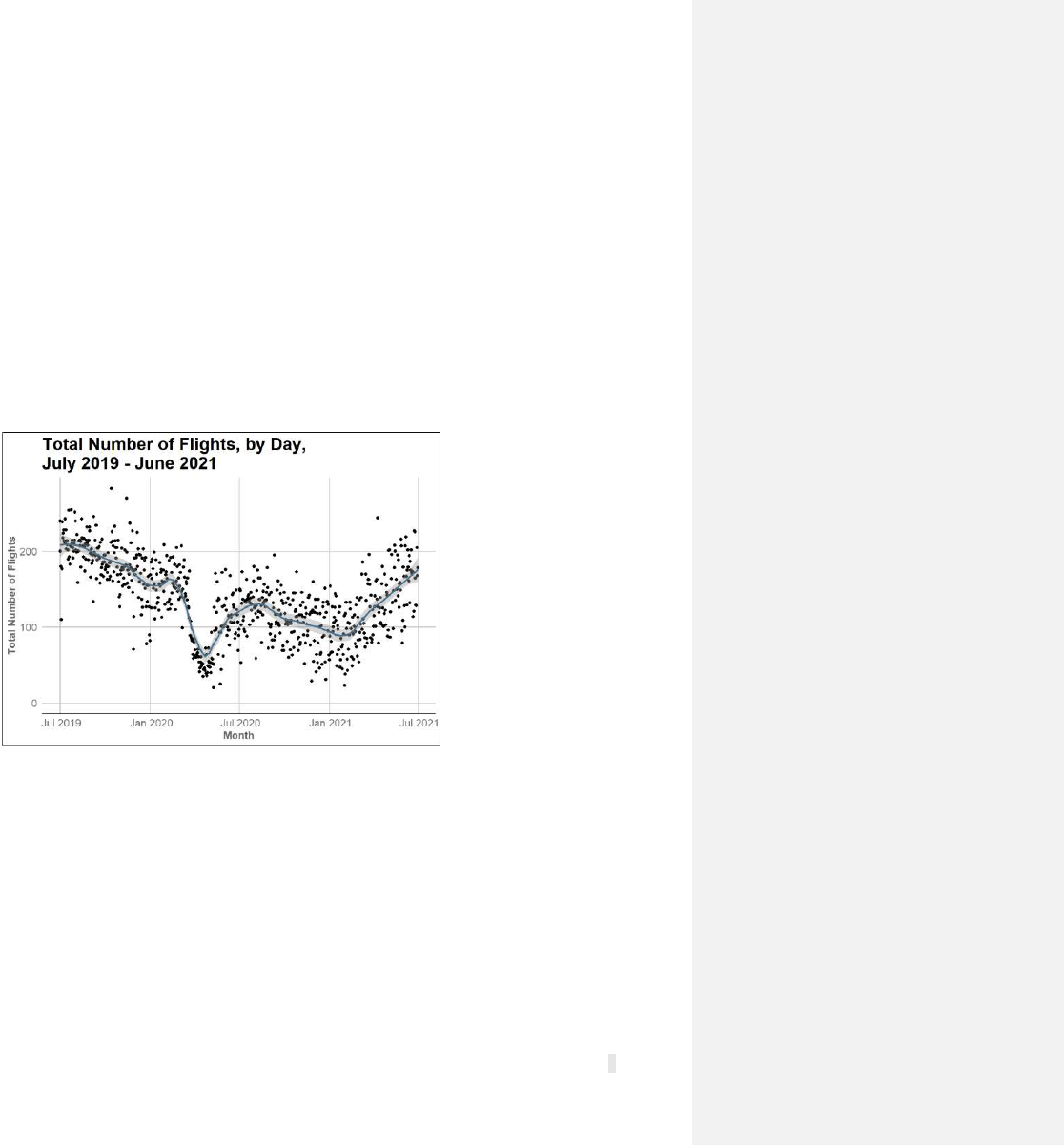
8 | P a g e
Environmental and Temporal Effects
The many changes to daily life as a result of the COVID-19 pandemic are potential sources of
confounding over the past two years. There was a change in in flight counts during the
pandemic (Figure 2). While this may present an opportunity to examine the effects of changing
flight numbers on air pollution, many other factors that also changed during the same
timeframe due to COVID-19. Several of these changes involve other sources of pollution, such
as changes in auto use and decreases in manufacturing activity during lockdowns. Given that
these changes occurred simultaneously with changes in flight numbers and that quantitative
data available, we cannot correct for these potential sources of confounding. Due to the
atypical nature of this period and the inability to correct for these factors, our findings are not
conclusive and should not be extrapolated to other time periods. We hope to compare these
results in the future to other data sets, which might allow for a better understanding of the
conditions that contribute to pollutant formation, including airport activities.
Figure 2: Daily flight numbers were highly impacted by the COVID-19 pandemic. Points represent
individual day results, while the line represents a smoothed average daily number of flights. A sudden
dip was observed as a result of lockdowns early in the pandemic (March, 2020), and a steady decrease in
flights was observed through fall and winter of 2020 before a substantial increase in 2021.
Both black carbon and ultrafine particles exhibit strong seasonal trends. As seen in Figure 3,
black carbon levels peaked in late fall or winter and were lowest during the spring. The seasonal
trends on black carbon may result from seasonal effects on wind direction, which was
examined in previous reports. Particle counts (Figure 4) were highest in the middle of winter
and lowest in the summer. The particle count trend is likely driven by temperature, as
increasing temperature is known to be negatively correlated with particle count.
There is a notable discrepancy between the expected season trend and the Lydick particle
count data for this period. Although past data collected at the site follow the expected seasonal
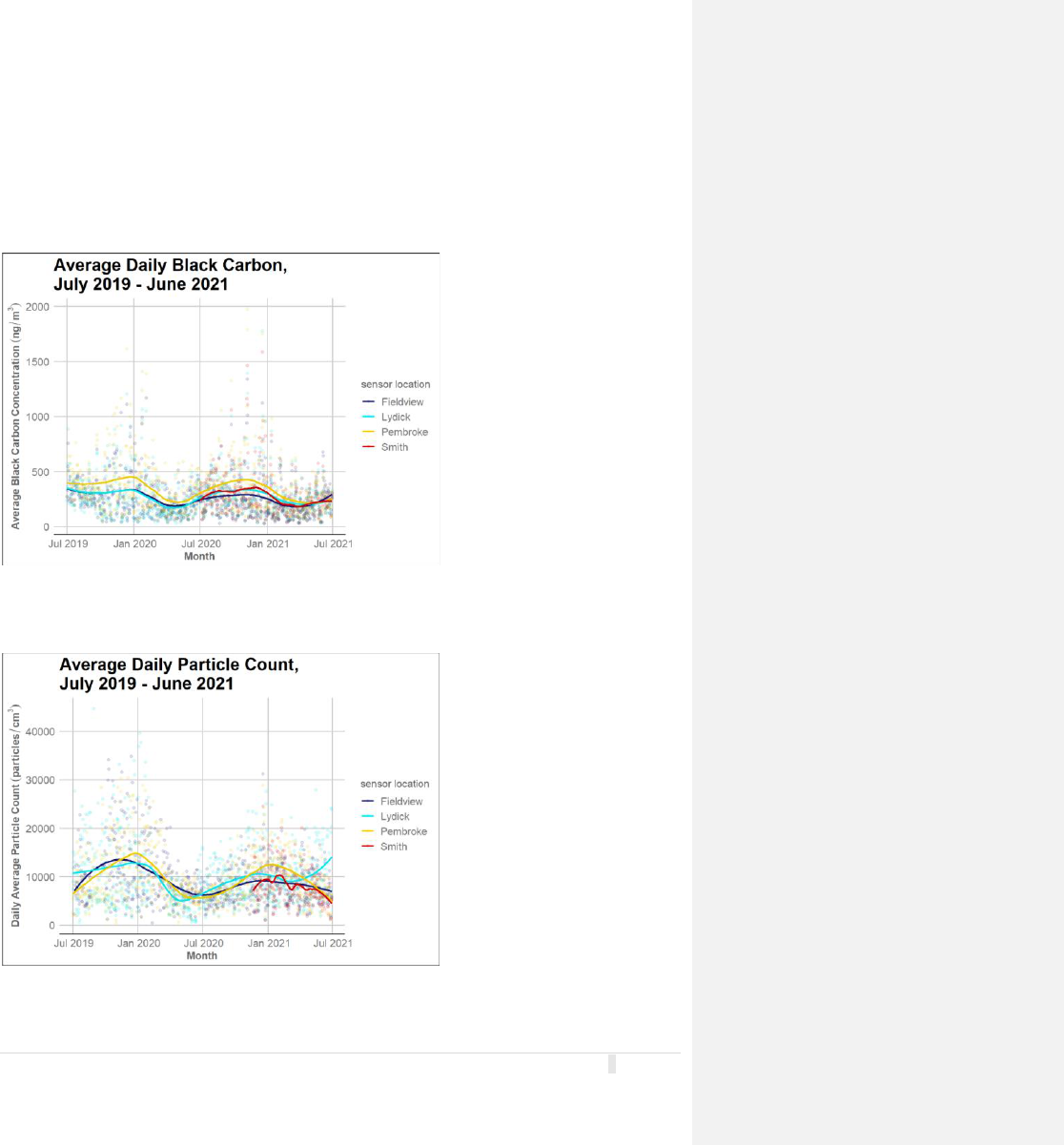
9 | P a g e
trends, the 2021 data diverge from this pattern. Rather than decreasing during the spring,
particle counts decreased slightly but then increased and had not peaked at the end of the
current study period on July 1, 2021. While new construction activity is one hypothetical cause,
no new construction nearby was seen on satellite maps. Another possibility is that this is
related to the increase in flight numbers, particularly smaller planes that operate out of the
north end of the airport closest to Lydick. The cause has yet to be identified.
Figure 3: Average daily black carbon levels showed clear seasonal trends, peaking in late fall or early
winter and reaching its lowest point in spring.
Figure 4: Average daily ultrafine particle counts showed clear seasonal trends, peaking in winter and
reaching its lowest point in the summer.
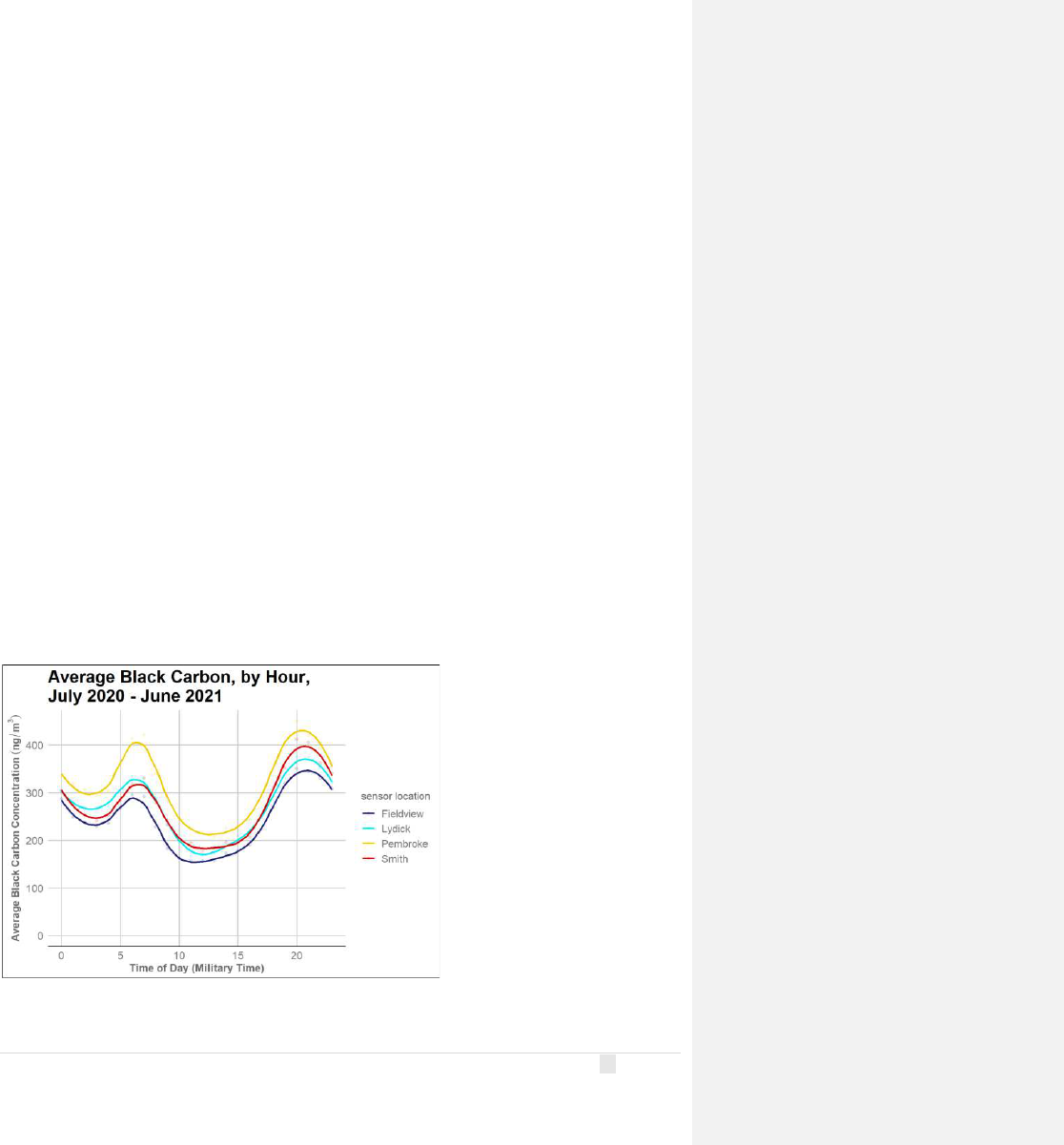
10 | P a g e
Both pollutants exhibited daily temporal trends (Figures 5 and 6) that included peaks around 6
a.m. and 8 p.m. and lows around 3 a.m. and 12 p.m. Particle count levels were lowest in the
early morning, when all values converged to approximately 5000 particles per cm
3
, while black
carbon was lowest midday. As was discussed in previous reports, the morning and evening
peaks observed for black carbon and ultrafine particles align with the times of morning and
evening commutes. A much smaller increase in particle count occurred midday, when hourly
flights peak (Figure 7), and no such increase was observed for black carbon. This suggests that
for the measured pollutants, highway activity is likely a greater contributor to temporal trends
than flight activity. Due to the lack of highway data, we are unable to examine the impact of
automobile traffic on the observed air quality in this year’s report.
The black carbon hourly trends were similar between locations, each displaying consistent
relative hourly values in relation to the other sites. There was more variability between hourly
particle count trends at each of the sites. The greater variability between sensor locations for
ultrafine particles compared to black carbon is expected; ultrafine particles do not travel as far
as black carbon and will be more affected by close sources rather than regional sources. Three
of the four sites exhibit a small mid-day increase in particle counts, around the same time that
hourly flights peak. This suggests that airport activity contributes more to ultrafine particles
than black carbon.
However, airport activity does not align with the morning or evening peaks in pollutants and
does not fully explain the temporal changes. Based on these data, it appears likely that the
pattern of automobile use is the biggest contributor to the relationship between time of day
and pollutant levels. The timing of flights has an observable effect on the average particle count
data by hour but not on the black carbon concentration by hour.
Figure 5: Average hourly black carbon followed a consistent trend across all sites with a strong peak in
morning and the evening, accompanied by subsequent decreases during midday and in the early
morning.
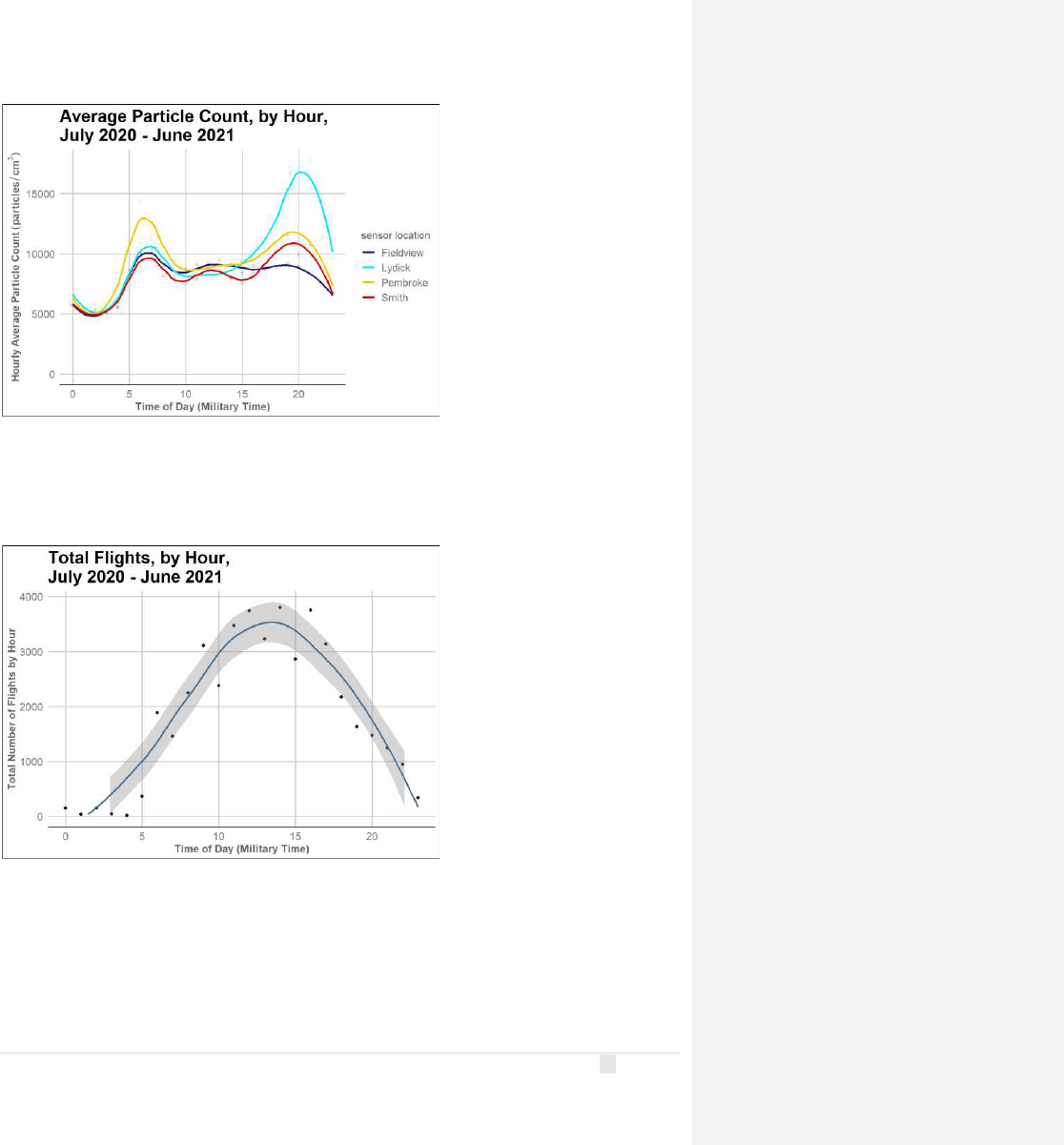
11 | P a g e
Figure 6: Average hourly ultrafine particle count followed a consistent trend across the sites, with a
strong peak in morning and the evening, accompanied by subsequent decreases during midday and in
the early morning. There was more variability between locations for particle count than was observed
for black carbon, and the midday dip was much less pronounced.
Figure 7: Flight activity by hour of the day exhibited a peak in early afternoon and almost no flights
between midnight and 5 a.m.
Seasonal trends for temperature, rainfall, wind speed, and wind direction were also considered
as sources of potential confounding for the relationship between pollution levels and flight
numbers. Trends for July 2020 – June 2021 resemble the previous year, and as such will not be
examined in depth in this report. Compared to last year, the only major meteorological
difference was there were more heavy rainfall days and fewer light rainfall days. Temperature
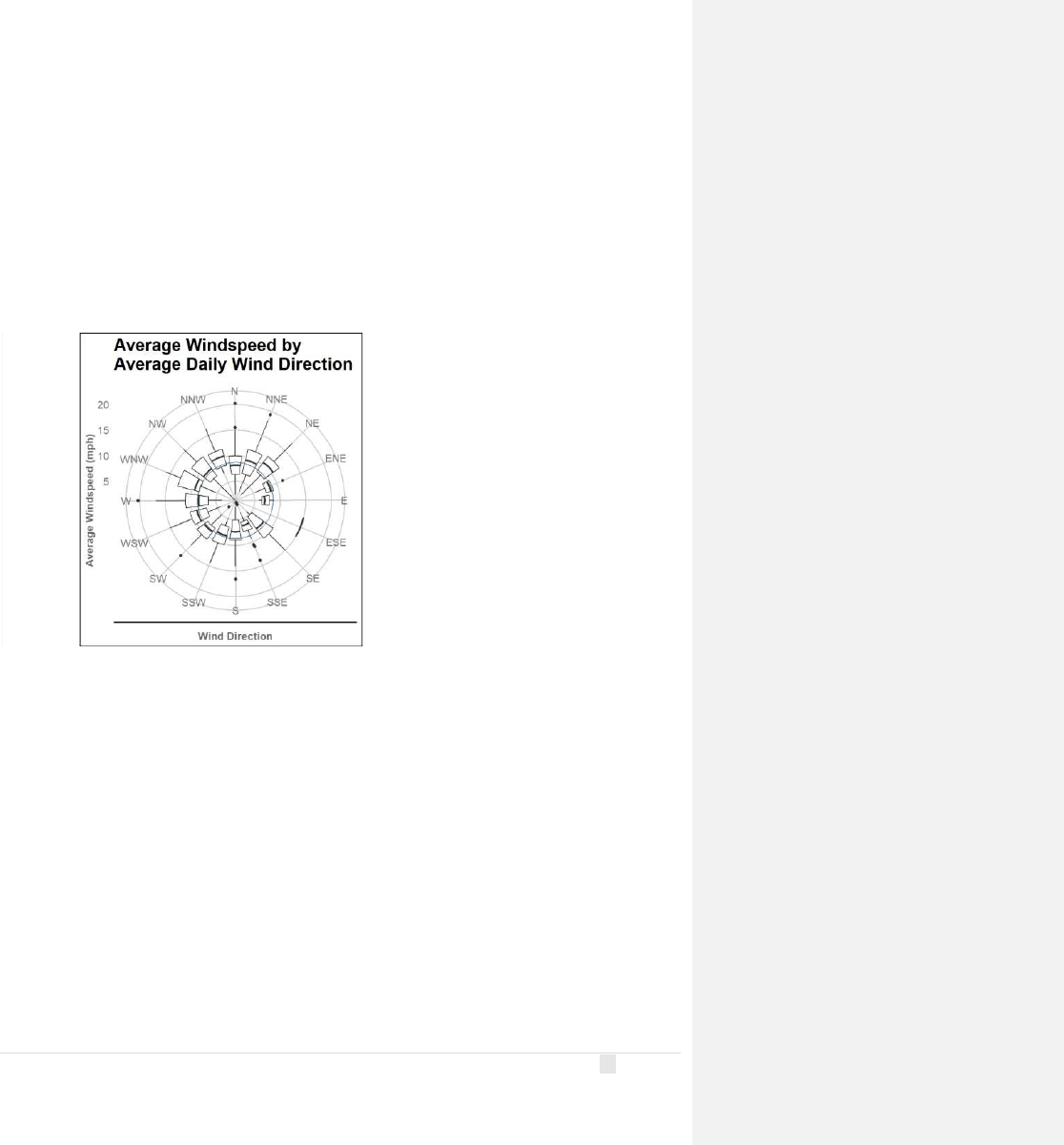
12 | P a g e
and wind direction showed the most seasonal variation, which is in line with previous year’s
observations.
Given that wind speeds vary by direction and that wind speed disperses pollutants, the
interaction between wind direction and wind speed was considered as a potential confounder
for their interaction with pollutant levels. As can be seen in Figure 8, wind speed is correlated
with wind direction, with lower wind speeds coming from the south and east. We did not
attempt to model this interaction, as controlling for wind direction resulted in small number
instability for several wind directions. For example, there was only one day of wind primarily
from the east-southeast.
Figure 8: Wind speed shows directional trends, with stronger windspeed from the north and west than
from the south or east.
Wind speed and rainfall are both anticipated to affect the number of flight operations. As can
be seen in Figure 9, wind speed is negatively correlated with flight count, meaning as wind
speeds increase the average number of daily flights decrease. This observation is in agreement
with the previous year’s observations. Figure 10 shows that while there were more daily flights
on days without rain than days with light or heavy rain, there were more flights on heavy rain
days than on light rain days. This differs from what was observed in previous years. The effect
of rainfall on flight numbers is relatively modest, and this discrepancy could result from random
chance or seasonal trends in both rainfall and flights.
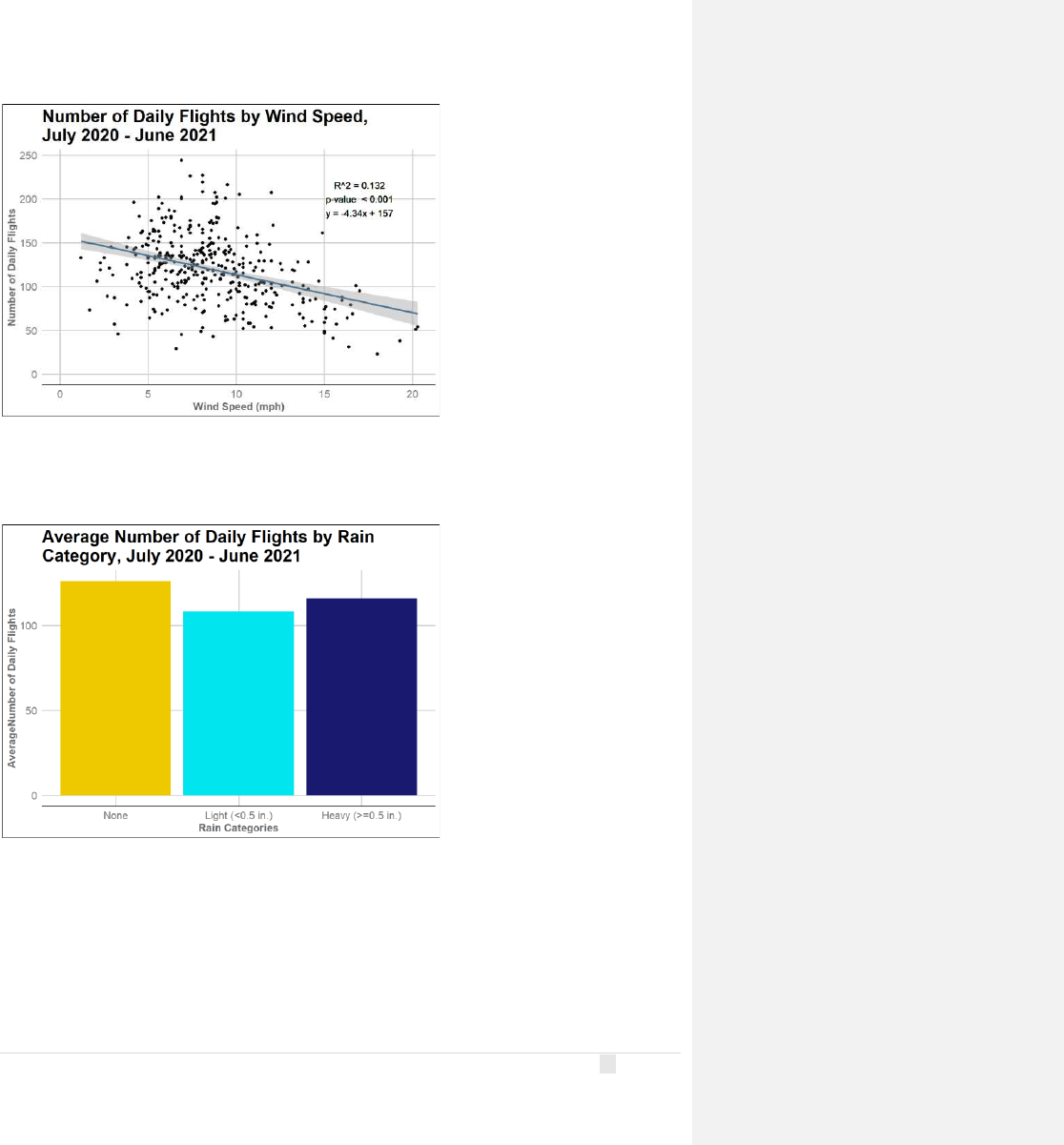
13 | P a g e
Figure 9: Wind speed is negatively correlated with the average number of daily flights. As hypothesized,
conditions with higher windspeeds result in fewer flights. This pattern is likely driven by small planes, as
RIAC reports that there are few weather-related cancellations of commercial flights.
Figure 10: Days with no rainfall averaged more flights than days with rainfall, but on average more daily
flights occurred on heavy rainfall than light rainfall days.
We also examined the amount of time that the sensors were collecting valid measurements
during the reporting period (Table 1). The target is to accurately collect 85.0% of the potential
data points (capture rate). This was achieved by all black carbon sensors examined, with an
average capture rate of 99.0%.
Three of the four particle count sensors reached this level as well, with an average of 88.4% of
the possible data points collected for all sites and times. The Smith sensor collected much less
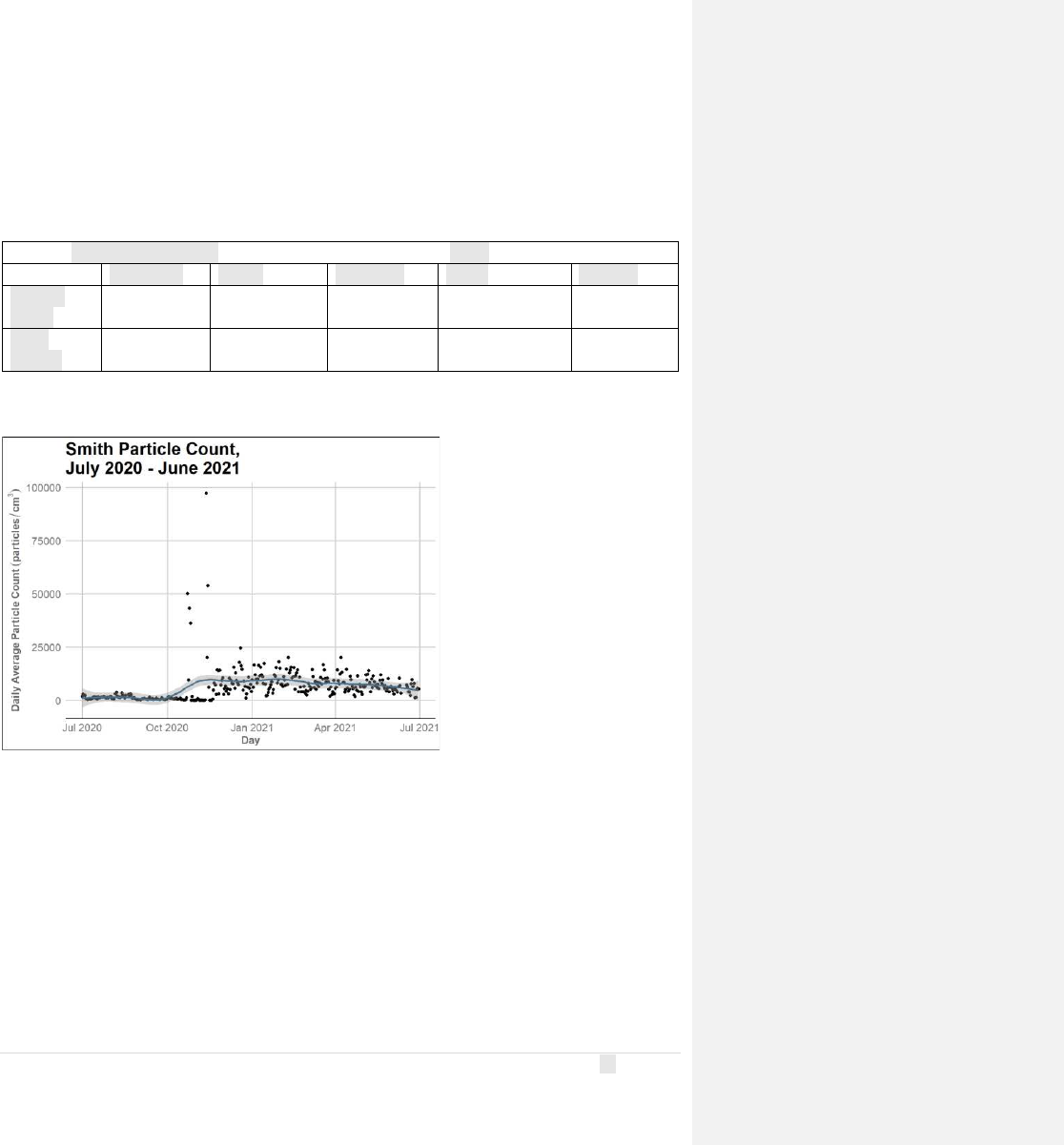
14 | P a g e
reliable data than the rest of the sensors, but the cause was identified and corrected during the
reporting period. There was a sensor malfunction from when the sensor was installed until
repairs were made, approximately November 20 (Figure 11). As such, these early values were
excluded from other analyses. When considering only the measurements taken post-exclusion
period, the capture rate is 96.7%, which is in line with the other sensor capture rates.
Table 1: Sensor Capture Rates, by Site, July 1, 2020 – June 30, 2021
Pembroke
Lydick
Fieldview
Smith
Average
Particle
Count
95.4%
99.8%
98.3%
60.0%*
88.4%
Black
Carbon
99.3%
98.5%
99.3%
99.0%
99.0%
*When excluding period of sensor malfunction, 96.7% capture rate.
Figure 11: Smith Particle Count, July 2020 - June 2021. As the chart illustrates, the sensor was
malfunctioning before approximately November 20, 2020. The data from the malfunctioning period has
been excluded from most analyses.
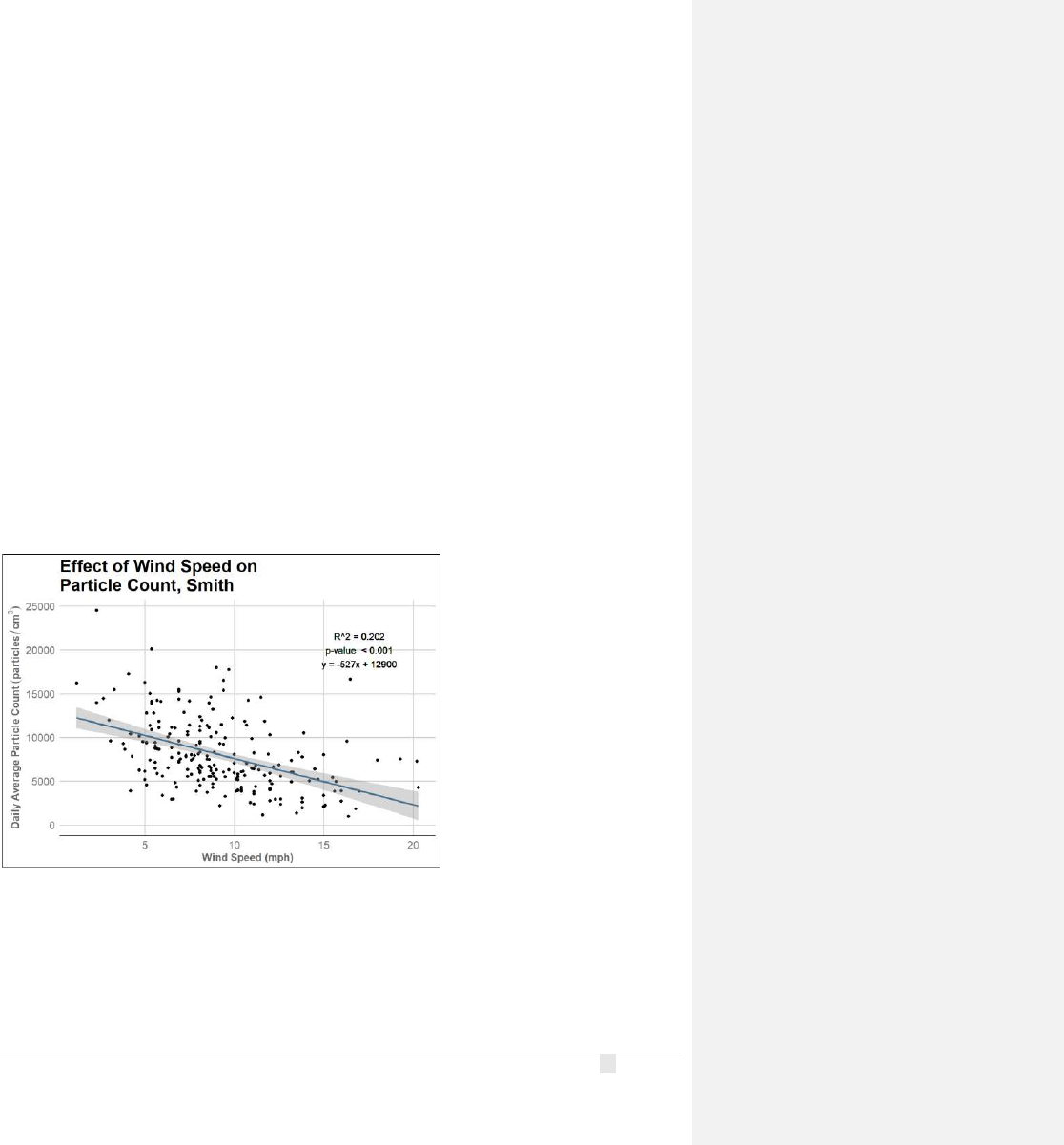
15 | P a g e
Particle Count Results
The 2017 Annual Report examined the particle count data on a time scale of minutes to hours.
It examined the effects of individual planes on the particle counts at downwind sites and trends
in particle count during different times of day. These results helped clearly establish a
relationship between specific aircraft operations and particle count. However, this fine level of
detail will be less useful for establishing relationships between the data collected at the sensors
and negative health effects, which are not easily available on those time scales. Thus, this
report focuses on examining the average particle count per day. The use of daily averages may
eventually allow for comparison of the pollution data collected at these sensor locations against
daily asthma and cardiovascular disease hospitalizations to see whether there is any interaction
between the two and better understand the health impacts of these pollutants, regardless of
their source. This analysis would be for scientific purposes and would not contribute to a health
advisory or other outcome associated with specific pollution measurements, given the local
nature of these measures.
There was a negative correlation between wind speed and particle count at all sites (Figures 12-
15). This is expected as higher wind speeds increase the rate of particle dispersion. The
observed correlations for three sites, Smith, Fieldview, and Lydick, were similar, while
Pembroke was least affected by windspeed.
Figure 12: Increasing wind speed was found to be correlated with decreasing particle count at the Smith
Street site.
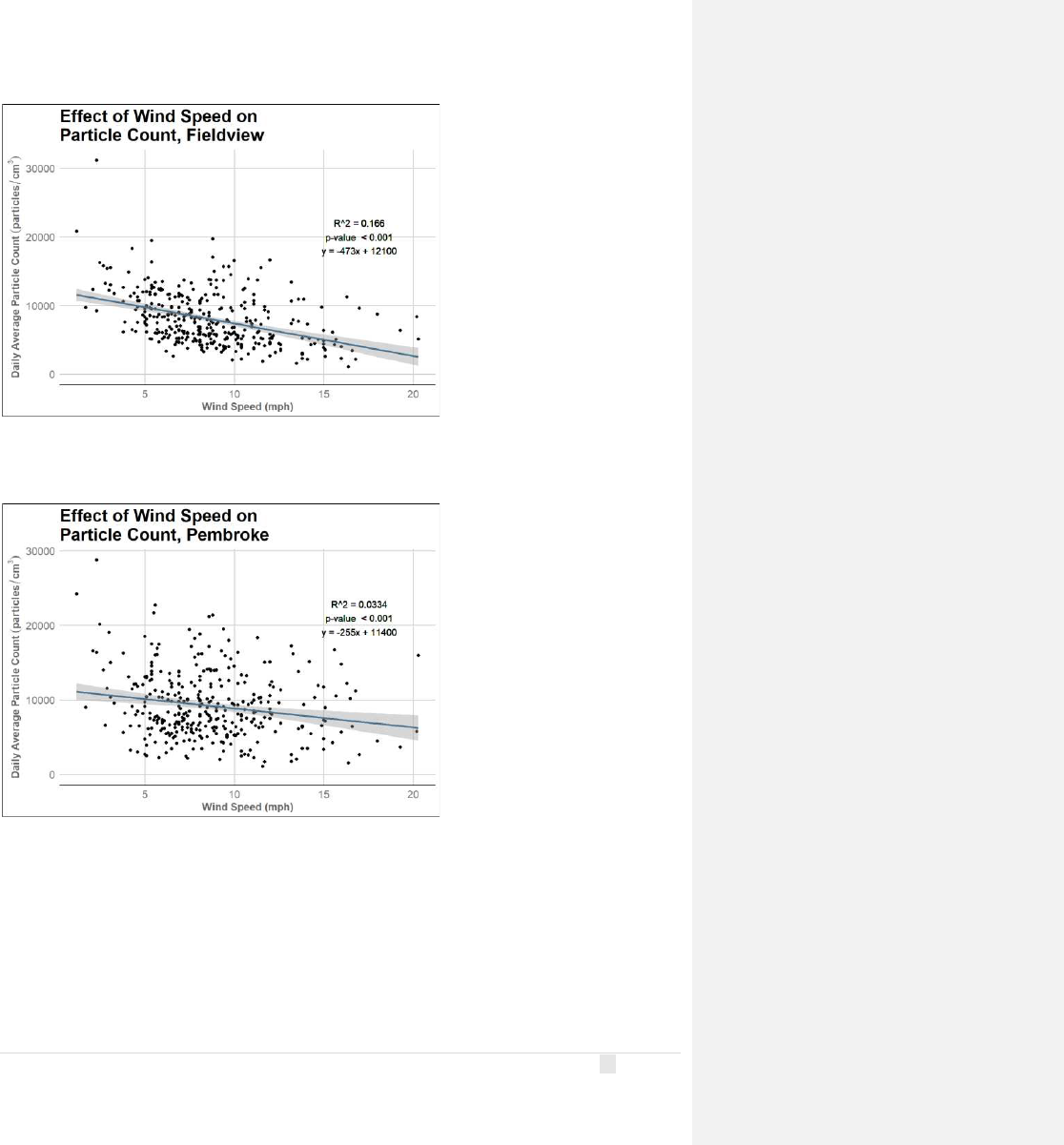
16 | P a g e
Figure 13: Increasing wind speed was found to be correlated with decreasing particle count at the
Fieldview site.
Figure 14: Increasing wind speed was found to be correlated with decreasing particle count at the
Pembroke site.
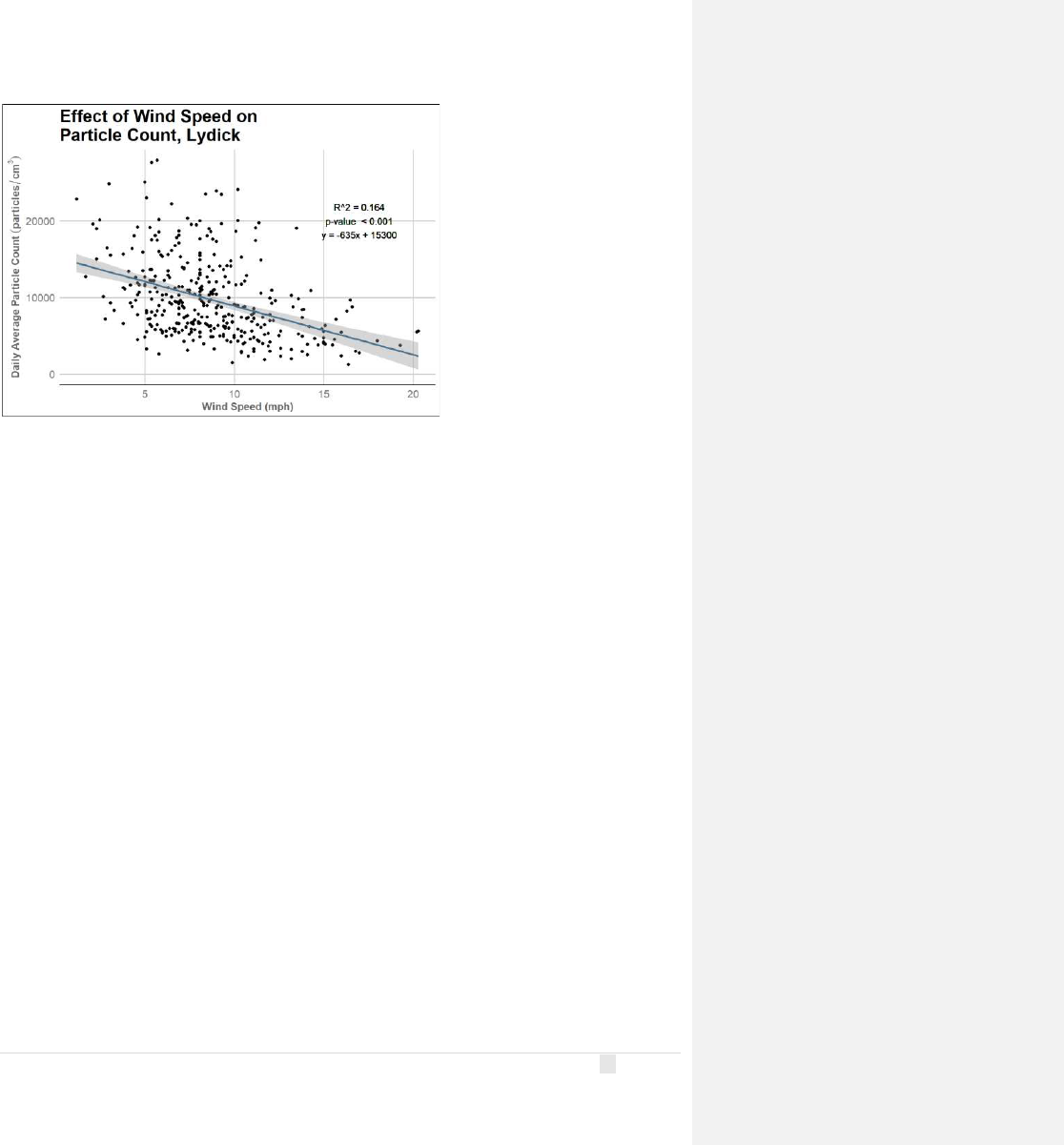
17 | P a g e
Figure 15: Increasing wind speed was found to be correlated with decreasing particle count at the Lydick
site.
Wind direction appeared to be one of the most significant factors in determining particle
counts at each site. Particle counts were two to three times higher on days when each monitor
was downwind of the airport compared to when the same monitor was upwind (Figures 16-19).
This is consistent with the hypothesis that activities at or near the airport contribute to ultrafine
particulate levels at these sites and was anticipated because ultrafine particles can only
disperse a limited distance from the source of emissions before converting into larger particles
of more regional significance.
Of the four sensors, Smith displayed the greatest variability. There are several causes for this.
One is the limited sample size for that site; it had fewer days of usable data and therefore is
more susceptible to random variability. Additionally, a number of the wind directions had very
limited number of recorded days—three for east and only one for east-southeast—which
further suggests some of these estimates will be unstable. Further monitoring will be needed to
determine if the east-northeast peak is real.
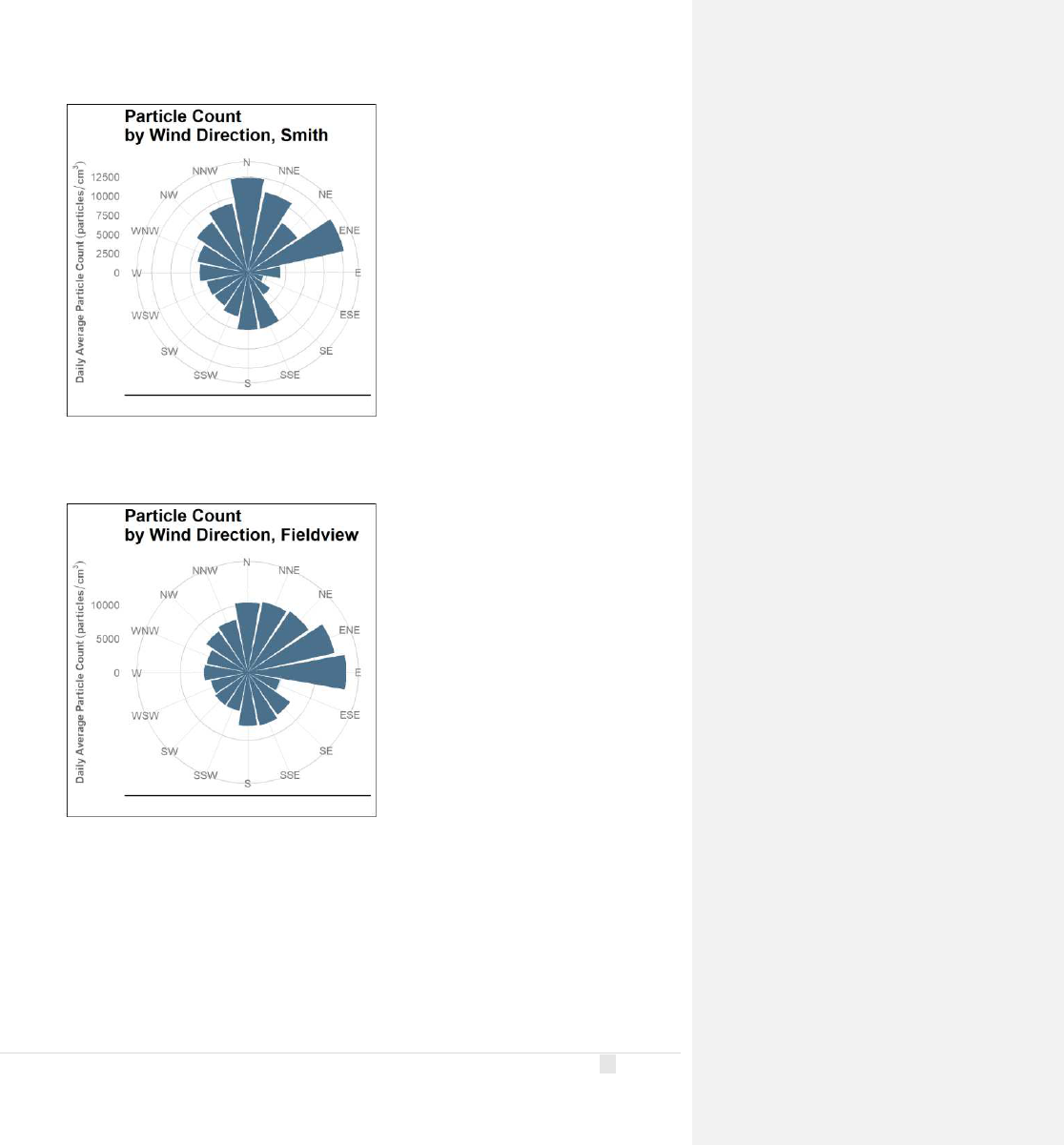
18 | P a g e
Figure 16: Ultrafine particle pollution was found to be highest when winds come from the north. A
second peak was detected to the east-northeast.
Figure 17: Particle counts were highest when winds come from east and northeast. East-southeast winds
were only observed on one day, which limits the interpretability of the low level observed.
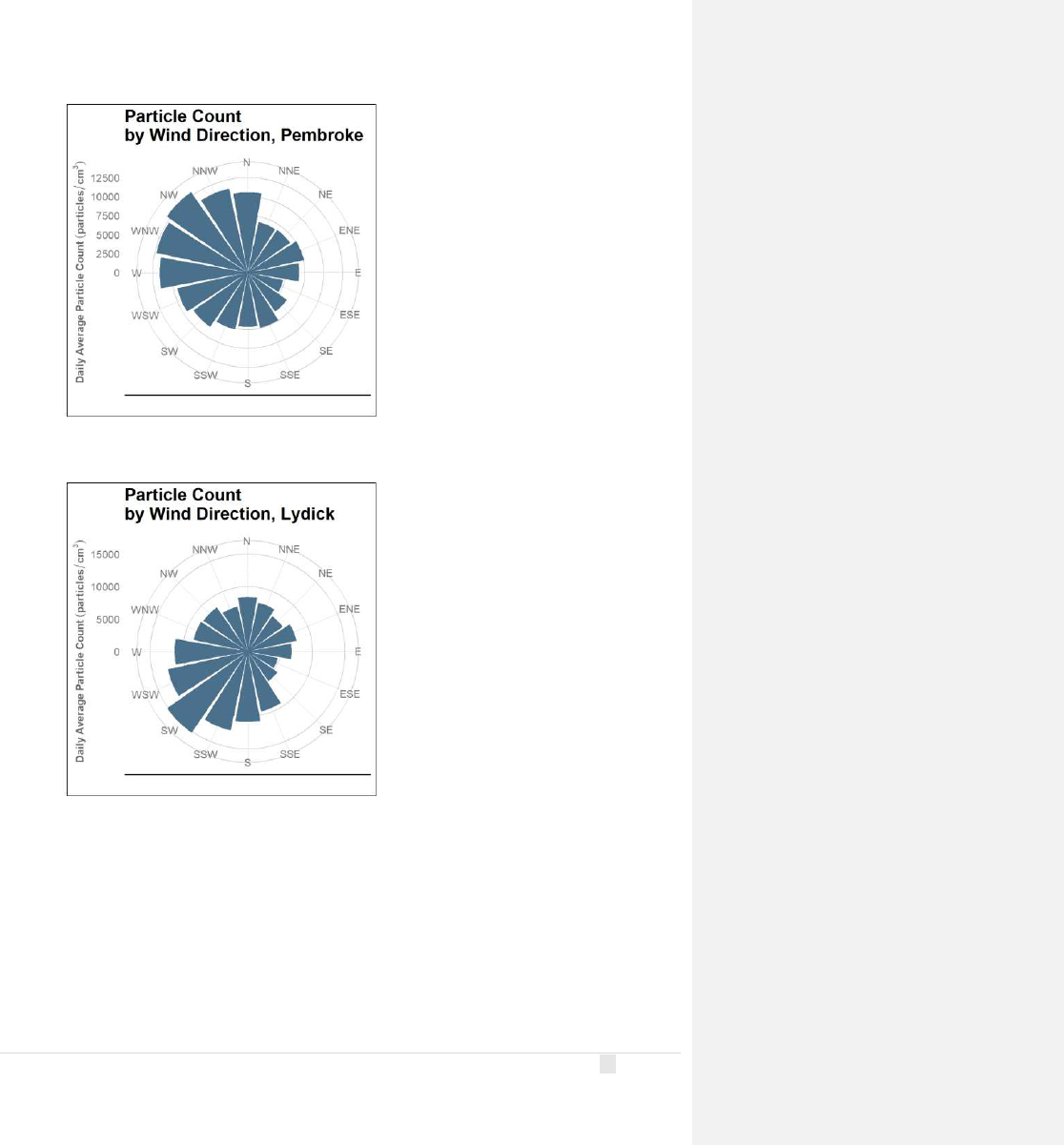
19 | P a g e
Figure 18: At the Pembroke station, particle counts were highest with winds from the northwest.
Figure 19: At the Lydick station, particle counts were highest with winds from the southwest.
Temperature was negatively correlated with particle count for Smith, Fieldview, and Pembroke,
but not for Lydick, as seen in Figures 20-23. Lower temperatures are expected to facilitate
particle formation by increasing the rate at which semi-volatile components of exhaust
condense. Lower temperatures may also slow particle aggregation by reducing evaporation. As
was noted in the previous reports, temperature has the strongest correlation with particle
counts at the Pembroke site. The differences between the strength of the correlation for the
three sites is likely due to the confounding effect of the relationship between temperature and
wind direction. Winds from the northwest, which would direct pollutants toward the Pembroke
station, are associated with Rhode Island’s coolest weather.
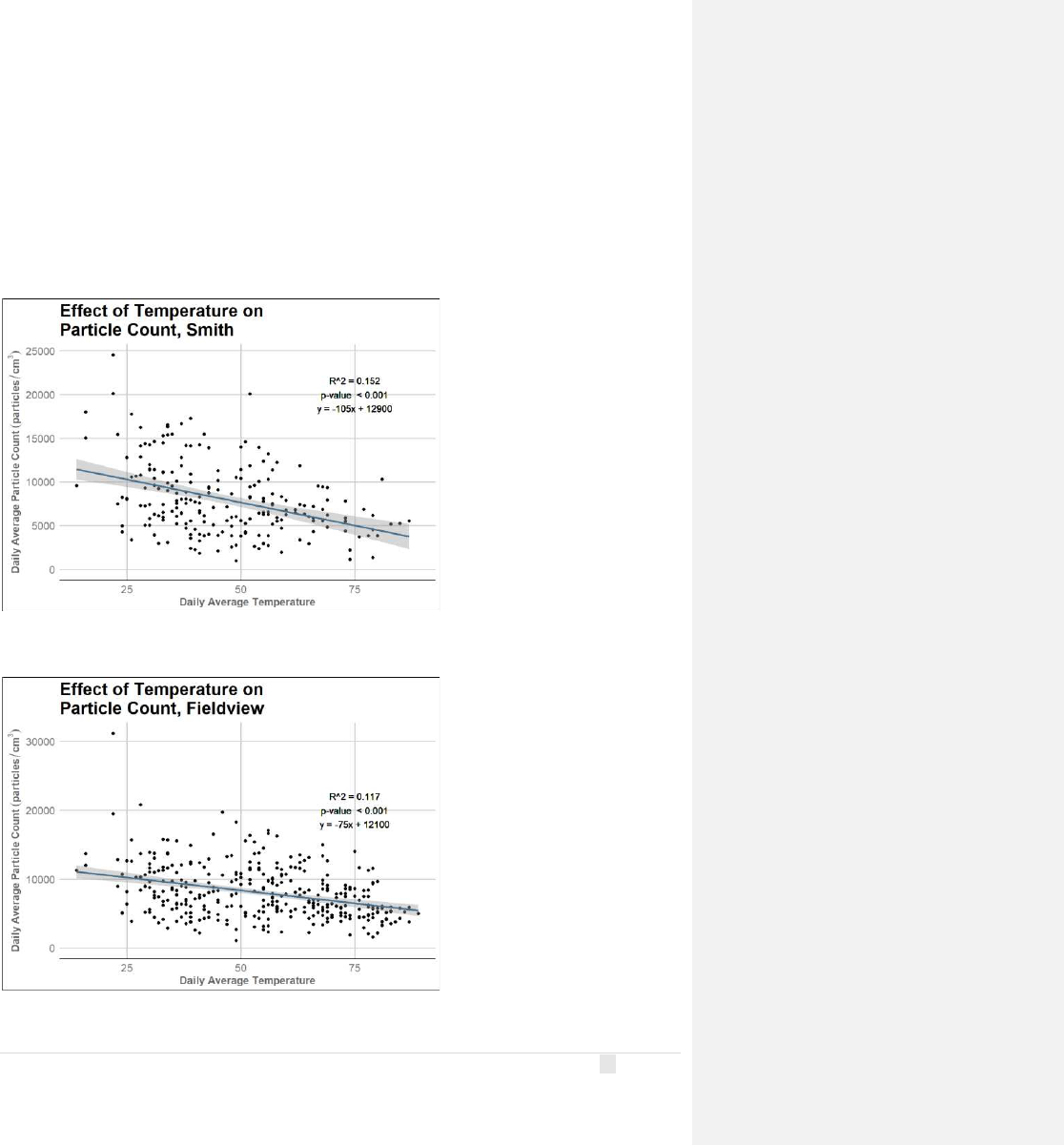
20 | P a g e
As was previously mentioned, the Lydick sensor exhibited anomalous seasonal trends. This may
be related to discrepant findings for temperature. Rather than exhibiting the expected seasonal
decrease in Spring 2021, the particle count increased during this time (Figure 23). This increase
may explain the lack of significance for the effects of temperature. However, the cause of that
increase has yet to be identified and further data will be needed to understand this finding.
Alternatively, the Lydick sensor is located to the north of the airport. Southerly winds are
associated with warmer temperatures and would direct particles from the airport and nearby
roads toward the Lydick station, which could also explain this discrepancy.
Figure 20: Ultrafine particle count is negatively correlated with temperature at the Smith site.
Figure 21: Ultrafine particle count is negatively correlated with temperature at the Fieldview site.
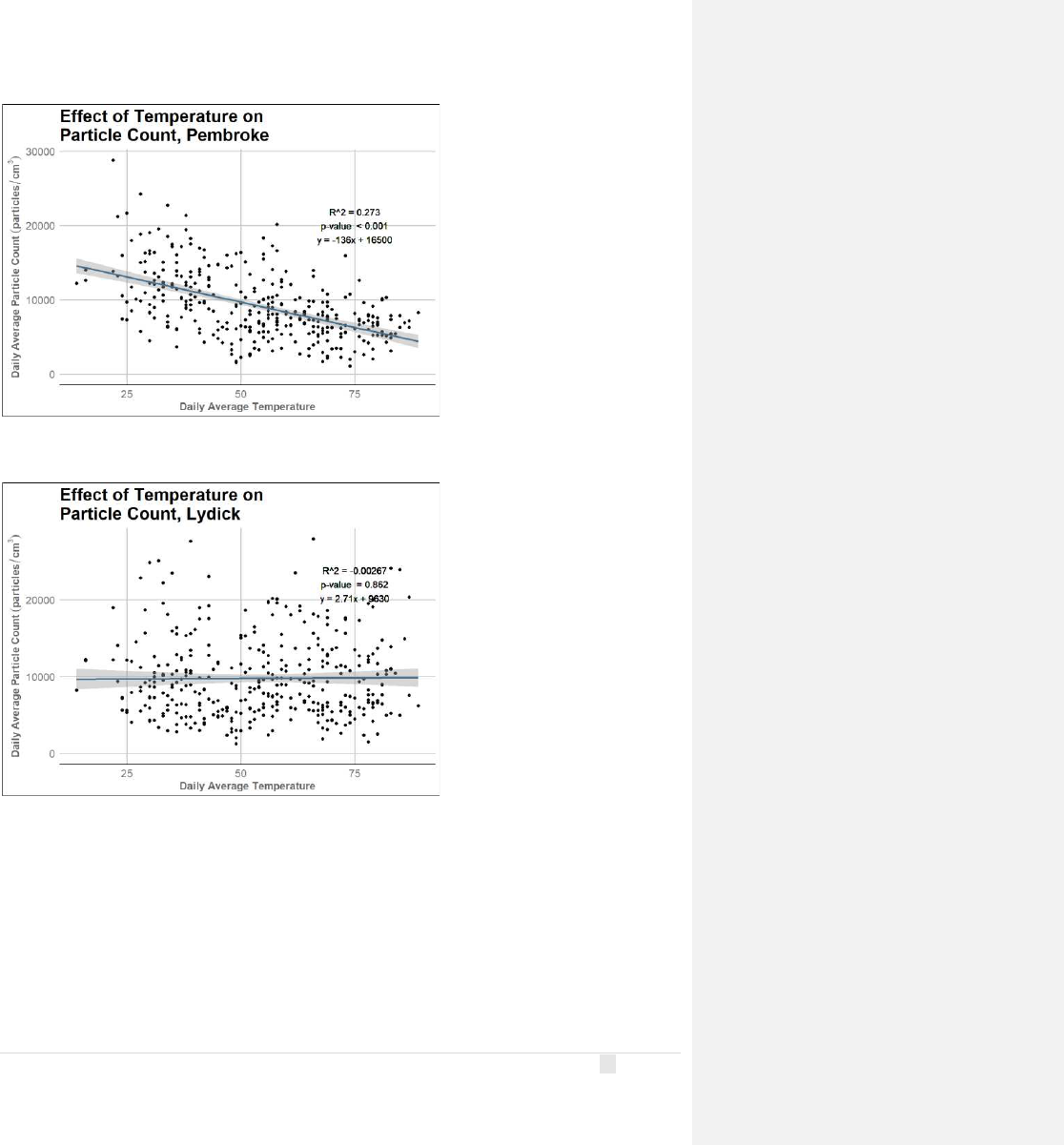
21 | P a g e
Figure 22: Ultrafine particle count is negatively correlated with temperature at the Pembroke site.
Figure 23: Ultrafine particle count was not correlated with temperature at the Lydick site.
Precipitation affects particle count, as seen in figure 24. The previous report hypothesized that
particles would be removed by precipitation. In this analysis, ultrafine particle levels were
found to be associated with rain category at three out of the four sites. Fieldview was the only
site that did not display these trends, with rainfall having little impact on particle count at the
site, as observed in the previous report. The lack of correlation at Fieldview could be a result of
a confounding effect of wind direction on precipitation levels.
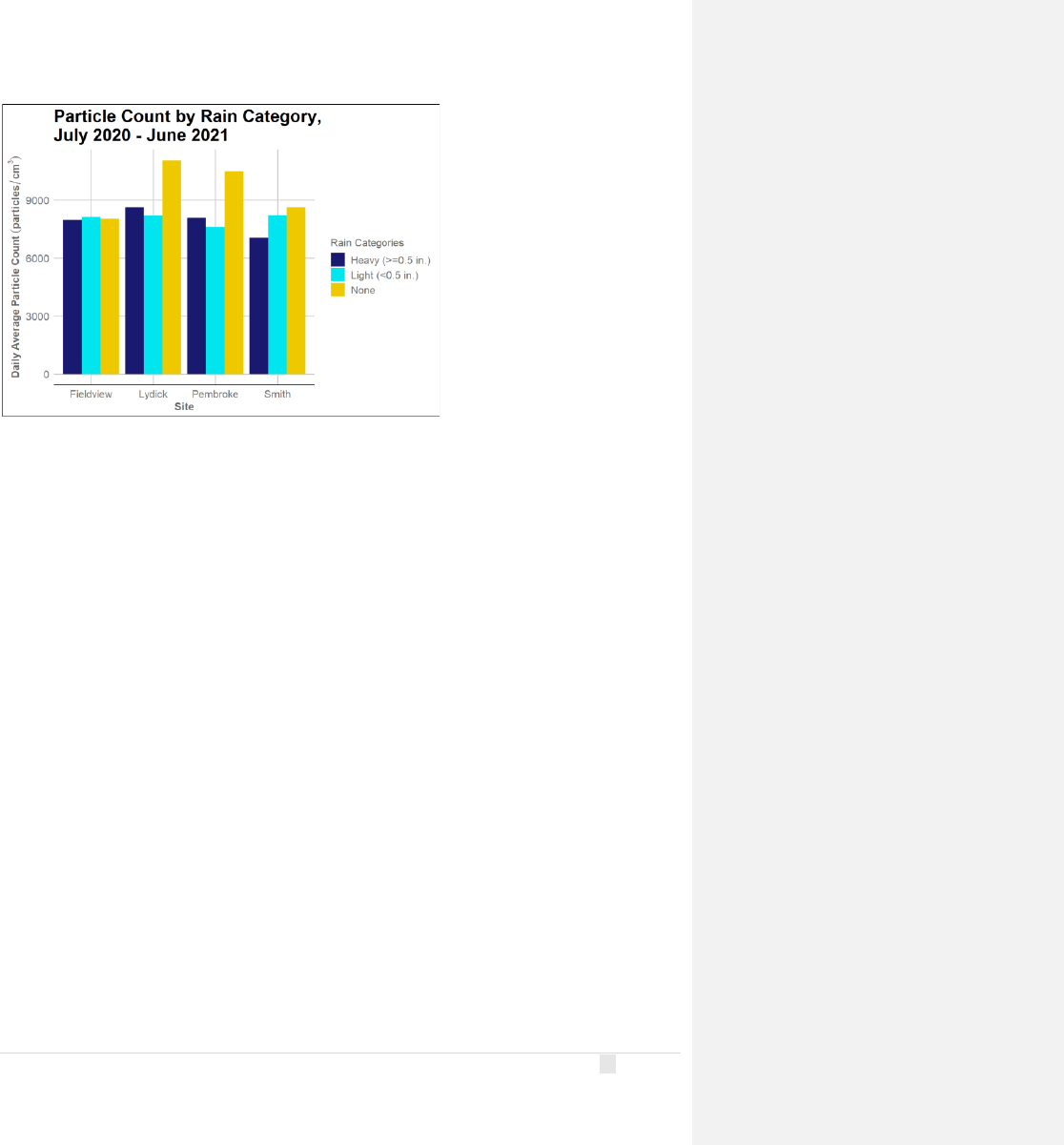
22 | P a g e
Figure 24: At all sites but Fieldview, rainfall resulted in a decreased daily average particle count, with
little difference between heavy and light precipitation days at all sites except Smith.
The correlation between daily number of flights and particle count was also considered (Figures
25-28). When not adjusting for confounders, there was a positive correlation between particle
count and number of flights for the Fieldview site and the Lydick site, but not at the Smith
Street or Pembroke sites. The correlation at the Fieldview sensor was small, with an R
2
value of
0.01. Similar trends were observed in the previous report. One potential explanation as to why
Lydick has the highest correlation with flights is that it is located nearest to the private hangars,
and small planes presumably account for much of the variability of daily flight numbers. Due to
this proximity, the particle counter at Lydick is most likely to detect the activity of smaller
planes, which is a hypothesis for why it would be most sensitive to the number of daily flights.
The lack of correlation at the other sites is likely the result of the various confounding factors,
including weather and traffic, that have a larger effect on air quality than flight numbers.
As in the last report, correction for meteorological factors led to a statistically significant
positive correlation between flight number and pollutant level at all four sites (data not shown).
However, this year, we were unable to get any traffic data, which limited our ability to examine
the relationship between flight number and particle count.
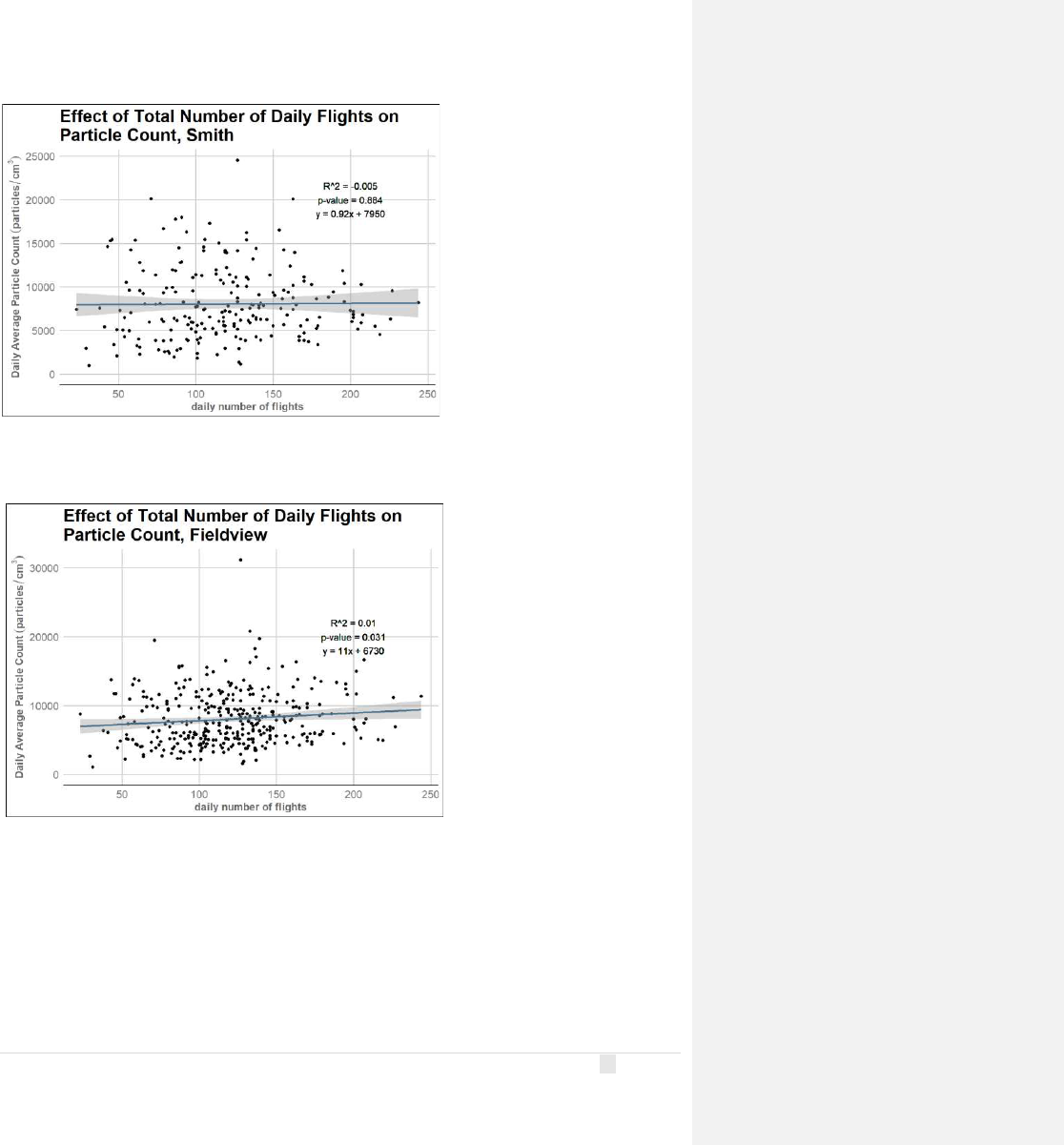
23 | P a g e
Figure 25: Without correcting for confounders, total number of daily flights was not significantly
correlated with particle count at the Smith site.
Figure 26: Without correcting for confounders, total number of daily flights was positively correlated
with particle count at the Fieldview Site.
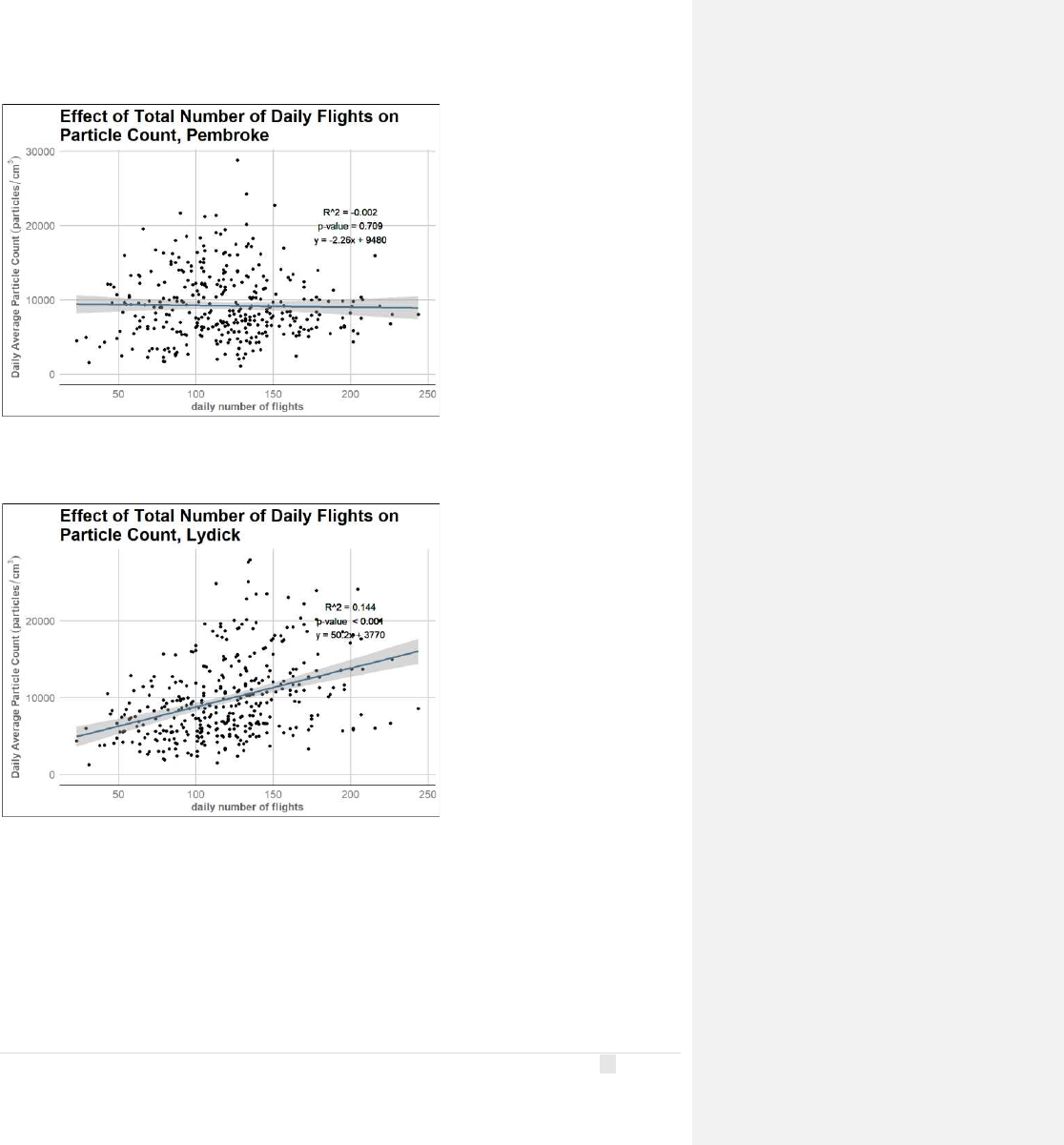
24 | P a g e
Figure 27: Without correcting for confounders, total number of daily flights was not significantly
correlated with particle count at the Pembroke site.
Figure 28: Without correcting for confounders, total number of daily flights was positively correlated
with particle count at the Lydick Site.
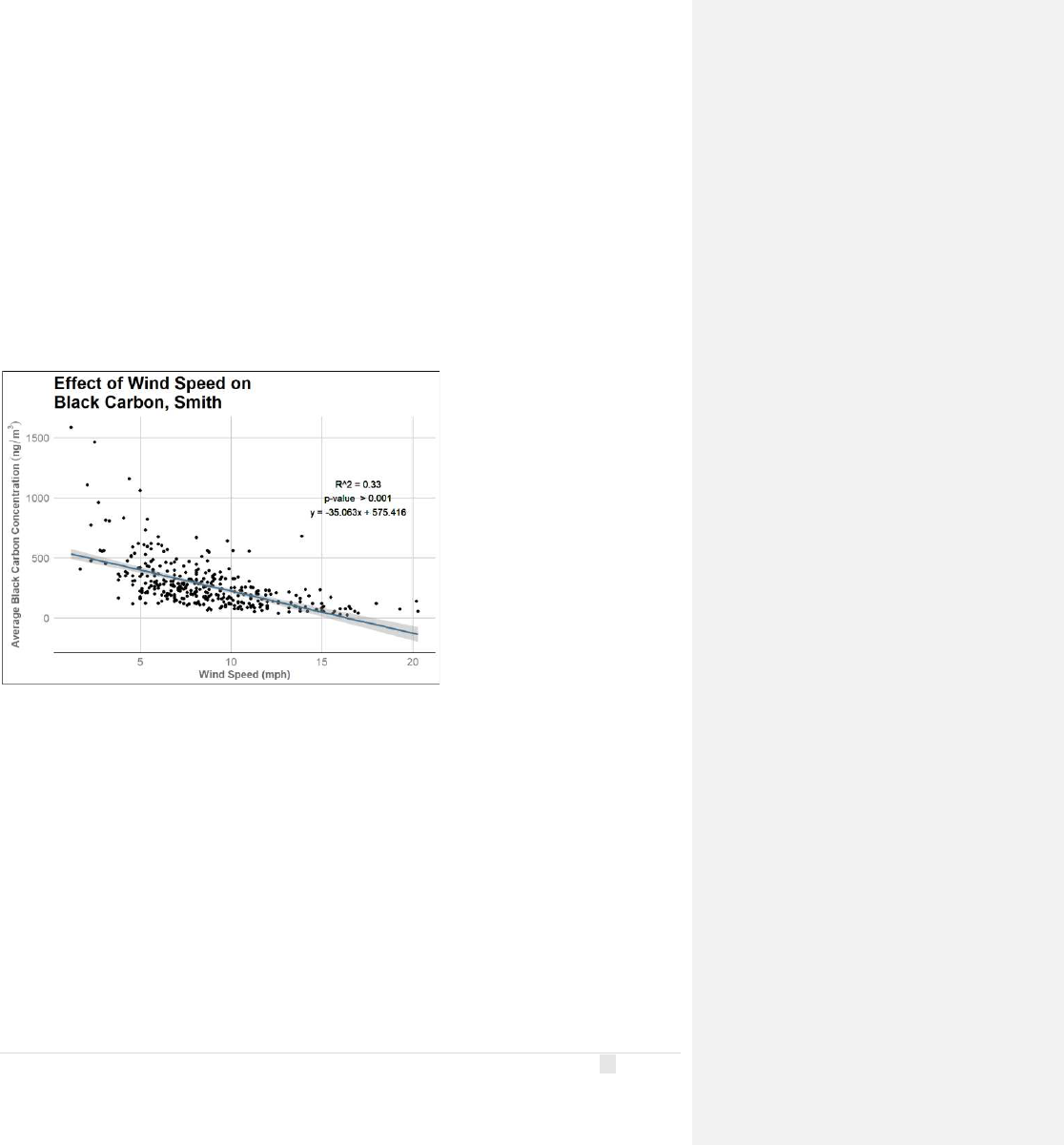
25 | P a g e
Black Carbon Results
We similarly examined the relationship between meteorological conditions and airport
activities and black carbon levels at each sensor.
Wind speed was well correlated with black carbon levels, as previously discussed for particle
count. Increasing wind speed was associated with decreases in black carbon concentration
(Figures 29-32). This effect was expected, as wind speed decreases pollution levels through
particle dispersal. Trendline estimates were drawn with linear regression; however, a nonlinear
trend that is more sensitive to the effects of wind at low speeds would better reflect the
distribution. This non-linear relationship was more pronounced for black carbon than for
particle count, although it was also apparent for particle count.
Figure 29: Increasing wind speed was found to be correlated with decreasing black carbon at the Smith
site.
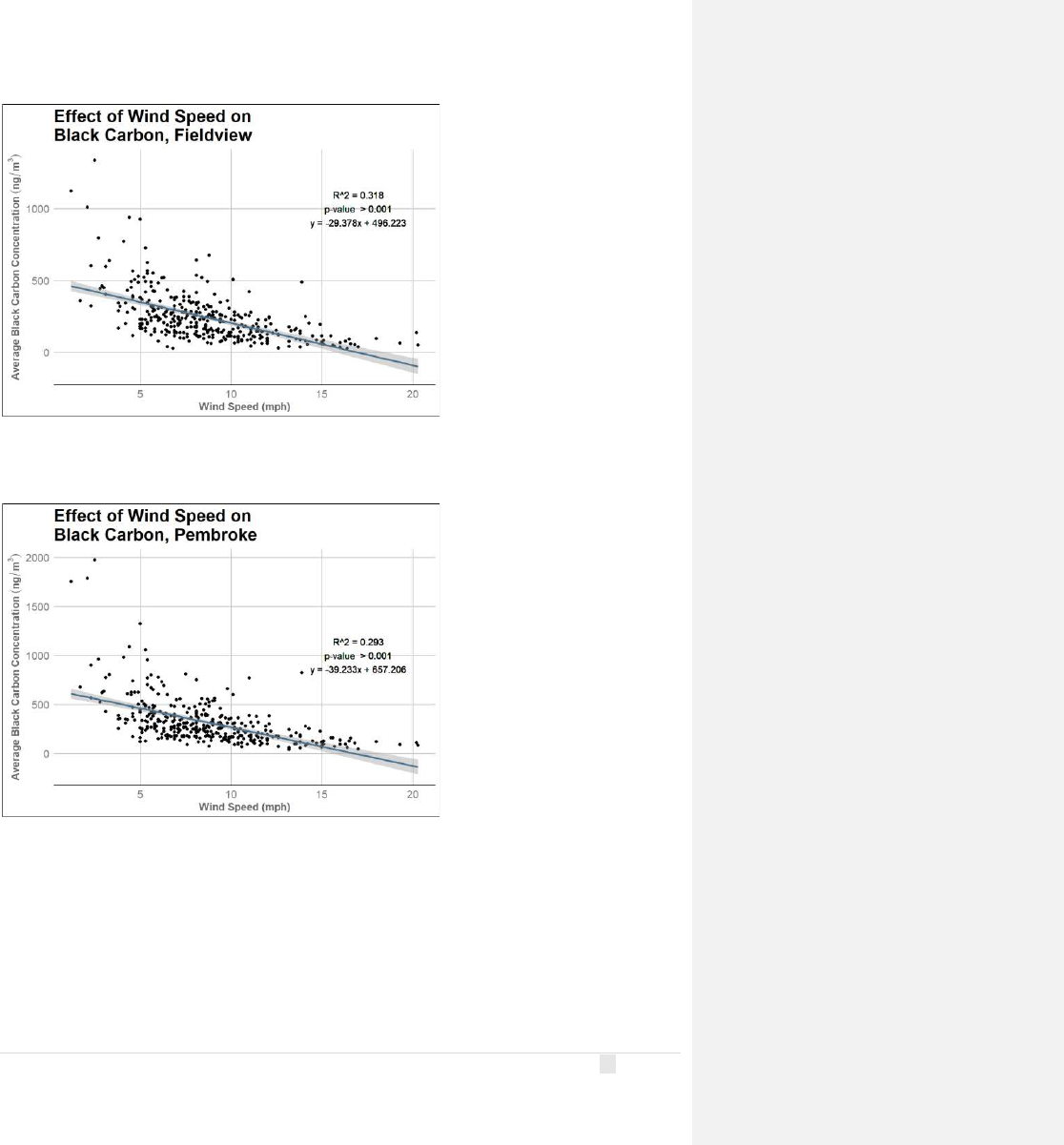
26 | P a g e
Figure 30: Increasing wind speed was found to be correlated with decreasing black carbon at the
Fieldview site.
Figure 31: Increasing wind speed was found to be correlated with decreasing black carbon at the
Pembroke site.

27 | P a g e
Figure 32: Increasing wind speed was found to be correlated with decreasing black carbon at
the Lydick site.
The relationship between wind direction and black carbon concentration differed from that
observed for particle count. The different stations exhibited a similar response to each other
with differing wind directions, as seen in Figure 33. In contrast, wind direction’s relationship
with particle count was heavily influenced by the station’s placements in relation to the airport.
This suggests that the airport plays a much smaller role in local levels of black carbon than it
does for particle count, which is expected given the regional nature of black carbon and the
local nature of particle count.
Figure 33: Each of the four sensors displayed similar effects with regard to wind direction. For most
wind directions, the Pembroke station detected the highest average levels of black carbon, while
Fieldview detected the lowest.
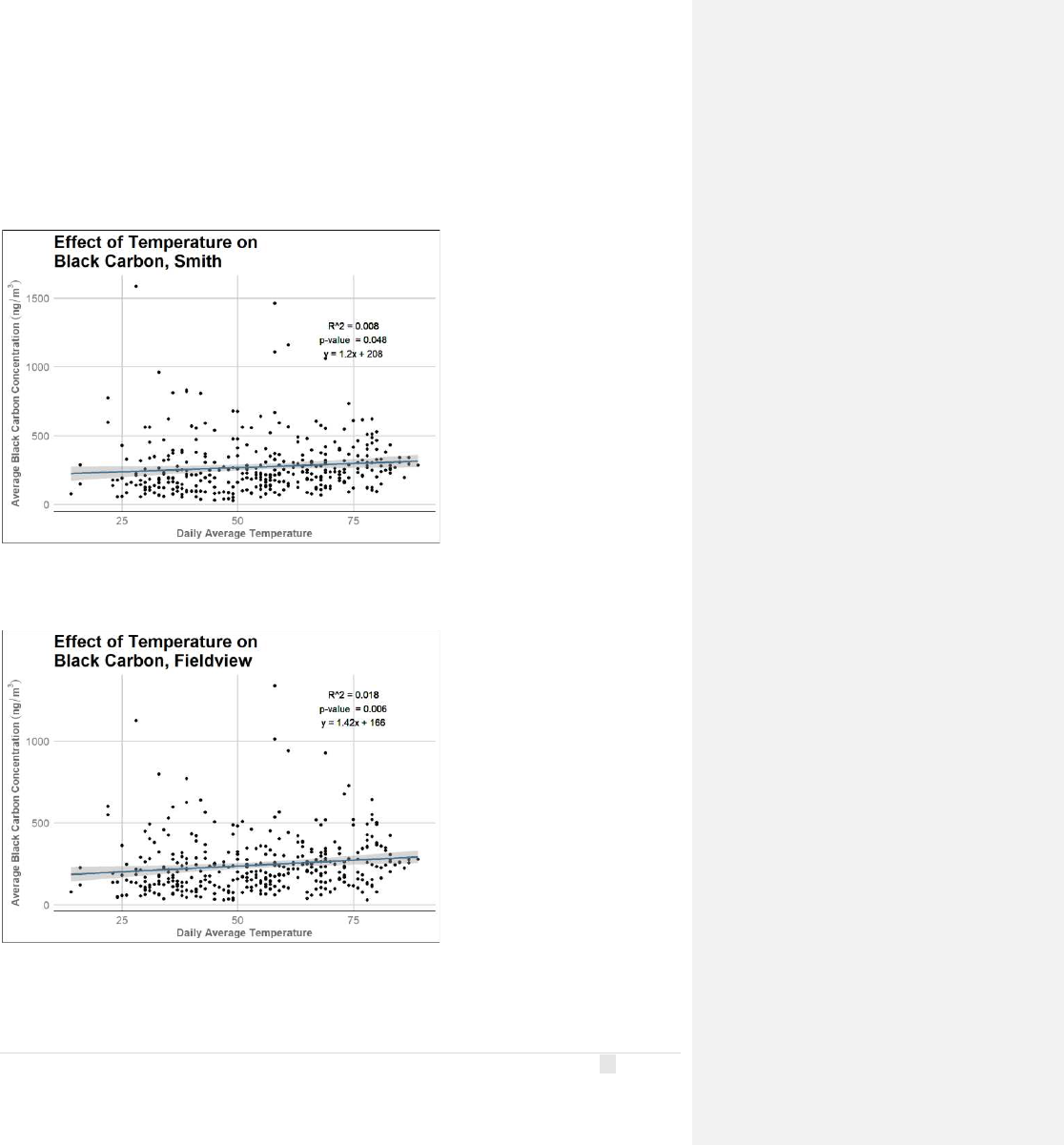
28 | P a g e
Unlike for particle count, temperature appears to have limited effect on black carbon
concentrations (figures 34-37), with either no association or a slight association between
increasing temperature and increasing black carbon. Black carbon levels are not affected by the
condensation and evaporation processes that were previously discussed for ultrafine particles.
These findings are consistent with earlier results.
Figure 34: Increasing temperature was correlated with increasing black carbon at the Smith Street site;
however, the impact over the observed temperature range was small.
Figure 35: Increasing temperature was found to be correlated with increasing black carbon at the
Fieldview site; however, the impact over the observed temperature range was small.
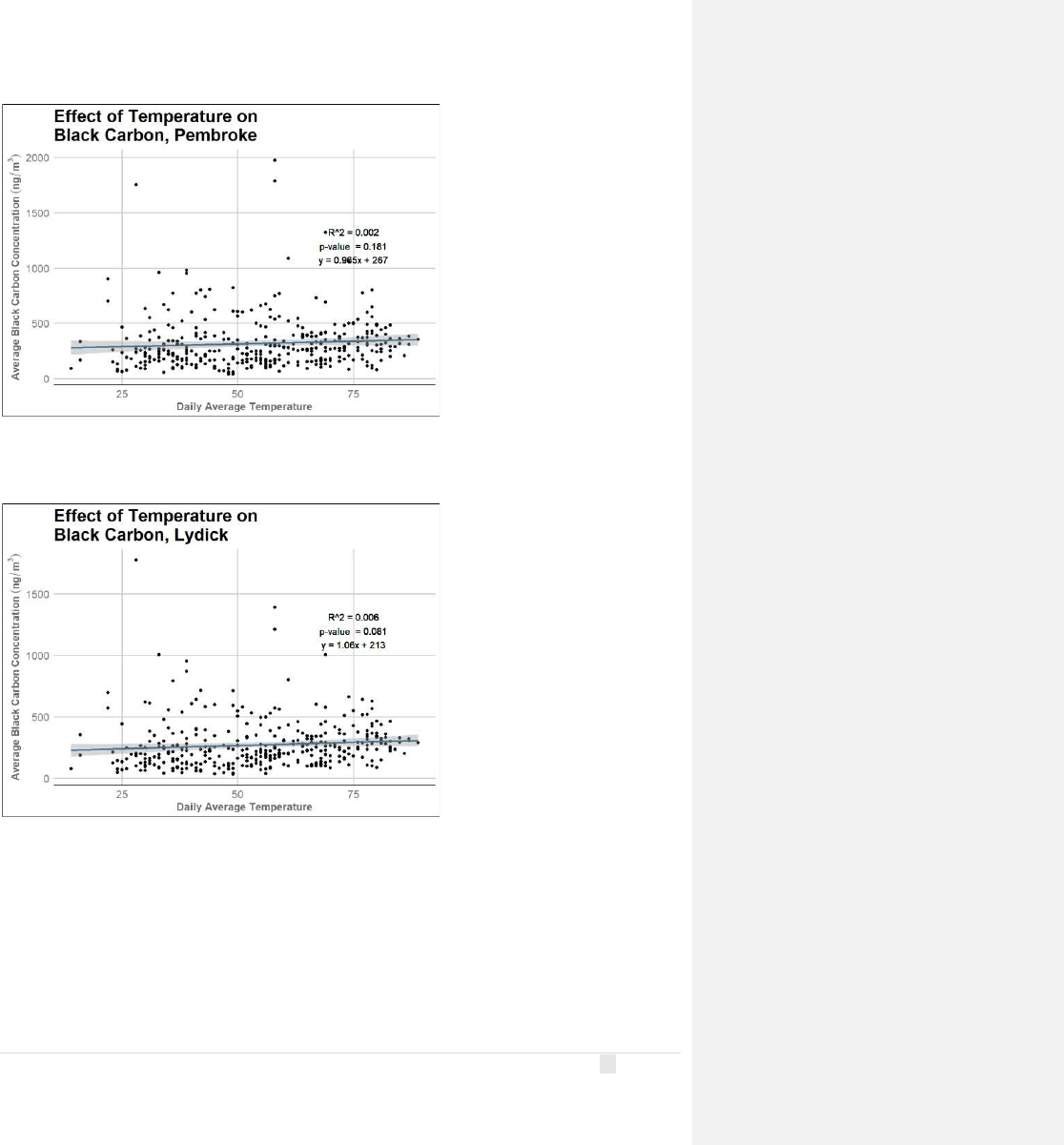
29 | P a g e
Figure 36: Increasing temperature was not found to be correlated with increasing black carbon at the
Pembroke site.
Figure 37: Increasing temperature was not found to be correlated with increasing black carbon at the
Lydick site.
The precipitation trends observed in Figure 38 support the hypothesis that rainfall decreases
black carbon levels. All sensors were similarly impacted by different rainfall categories. As was
observed in the previous report, no-rainfall days had the highest average black carbon levels;
however, this year the highest rainfall category had the lowest average black carbon levels,
whereas last year the light rainfall category had the lowest.
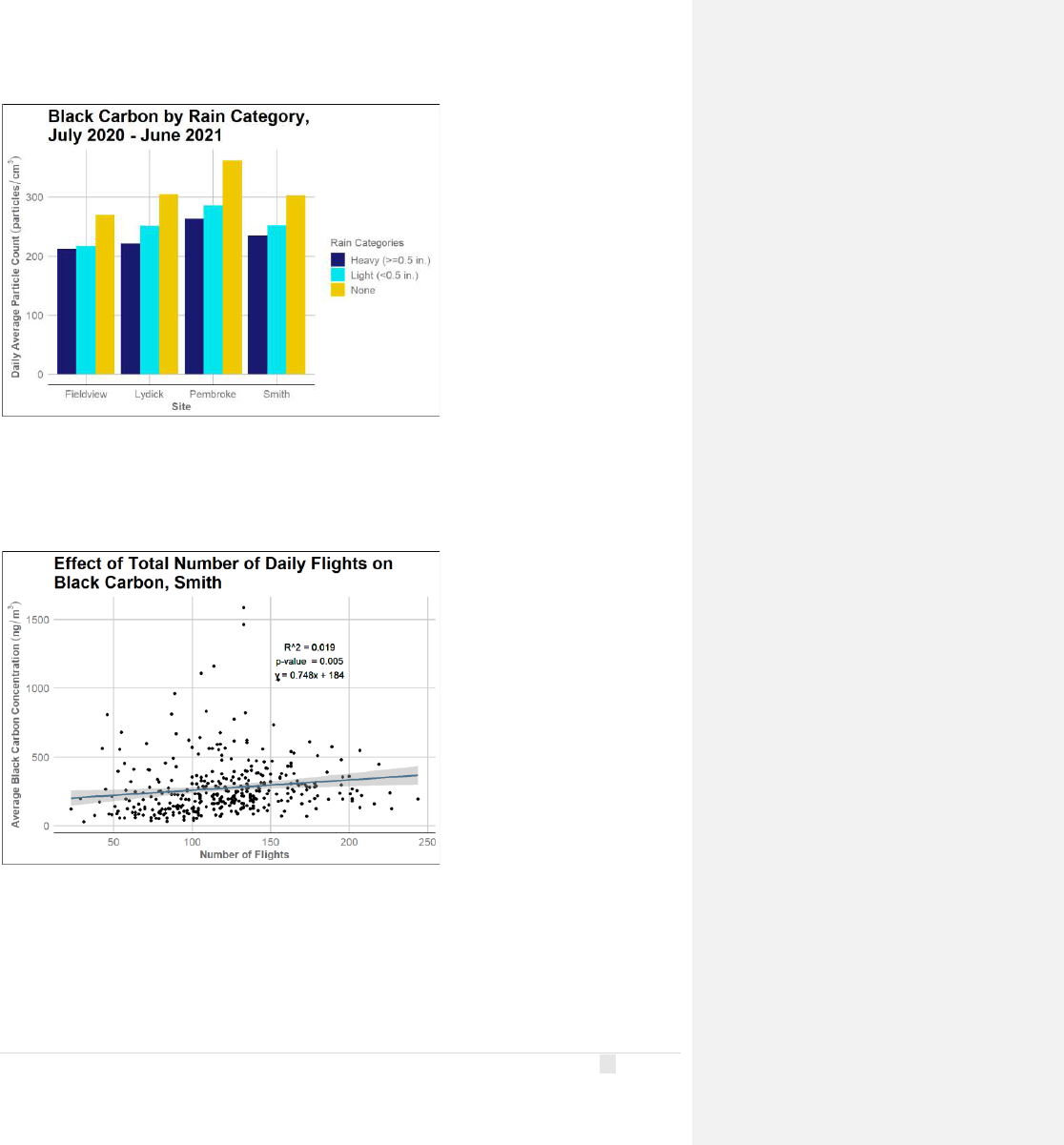
30 | P a g e
Figure 38: Rainfall was found to decrease the detected levels of black carbon at all sensor sites, and days
with heavy rainfall were found to have less average daily black carbon than light rainfall.
As seen in Figures 39-42, the total number of daily flights has a positive correlation with
measured levels of black carbon. This was found to be statistically significant at all sites,
however it was a minor contributor to overall concentrations in all locations, with low R
2
values.
Figure 39: Increasing numbers of daily flights were found to be correlated with increasing black carbon
at the Smith site.

31 | P a g e
Figure 40: Increasing numbers of daily flights were found to be correlated with increasing black carbon
at the Fieldview site.
Figure 41: Increasing numbers of daily flights were found to be correlated with increasing black carbon
at the Pembroke site.
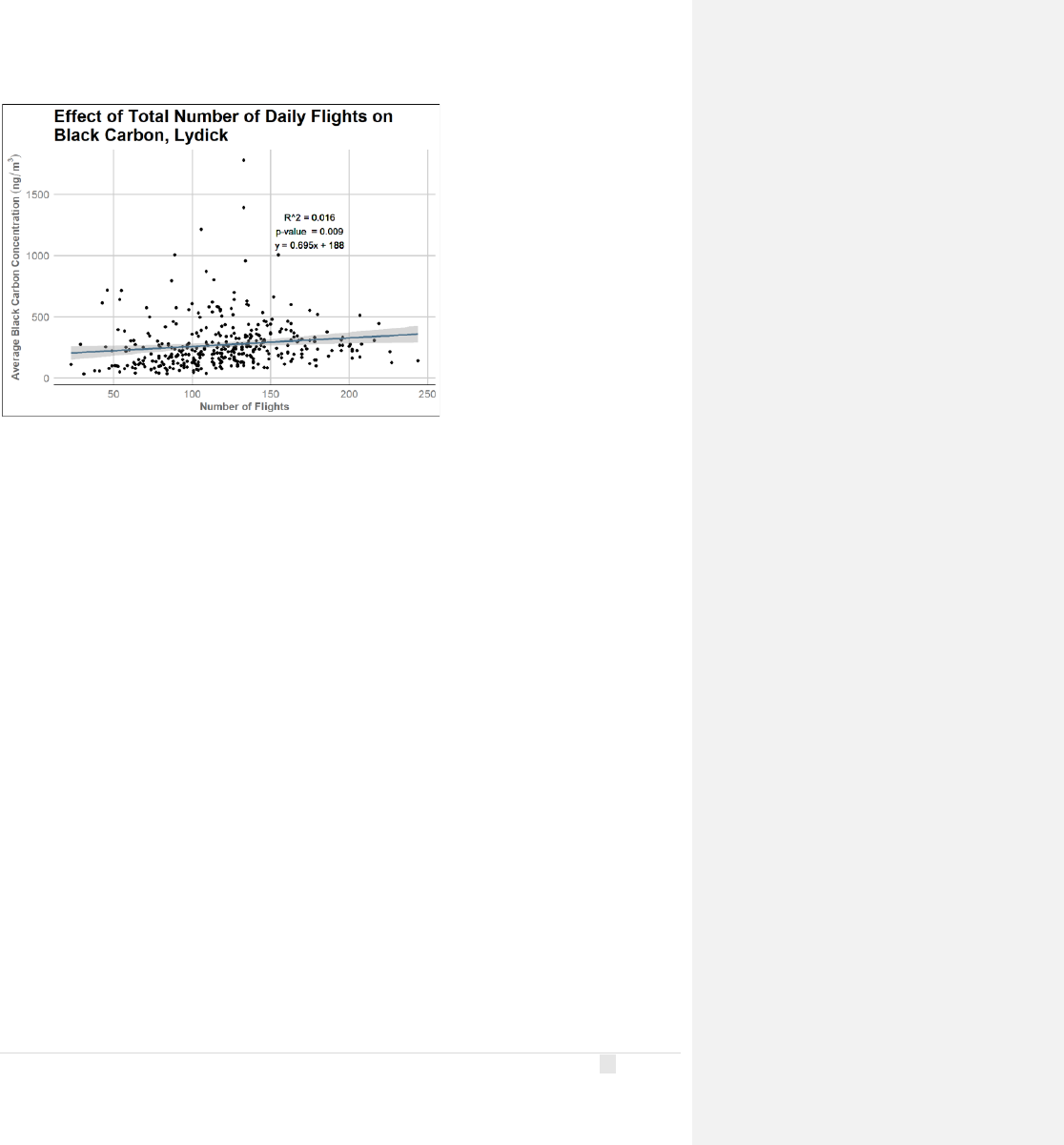
32 | P a g e
Figure 42: Increasing numbers of daily flights were found to be correlated with increasing black carbon
at the Lydick site.
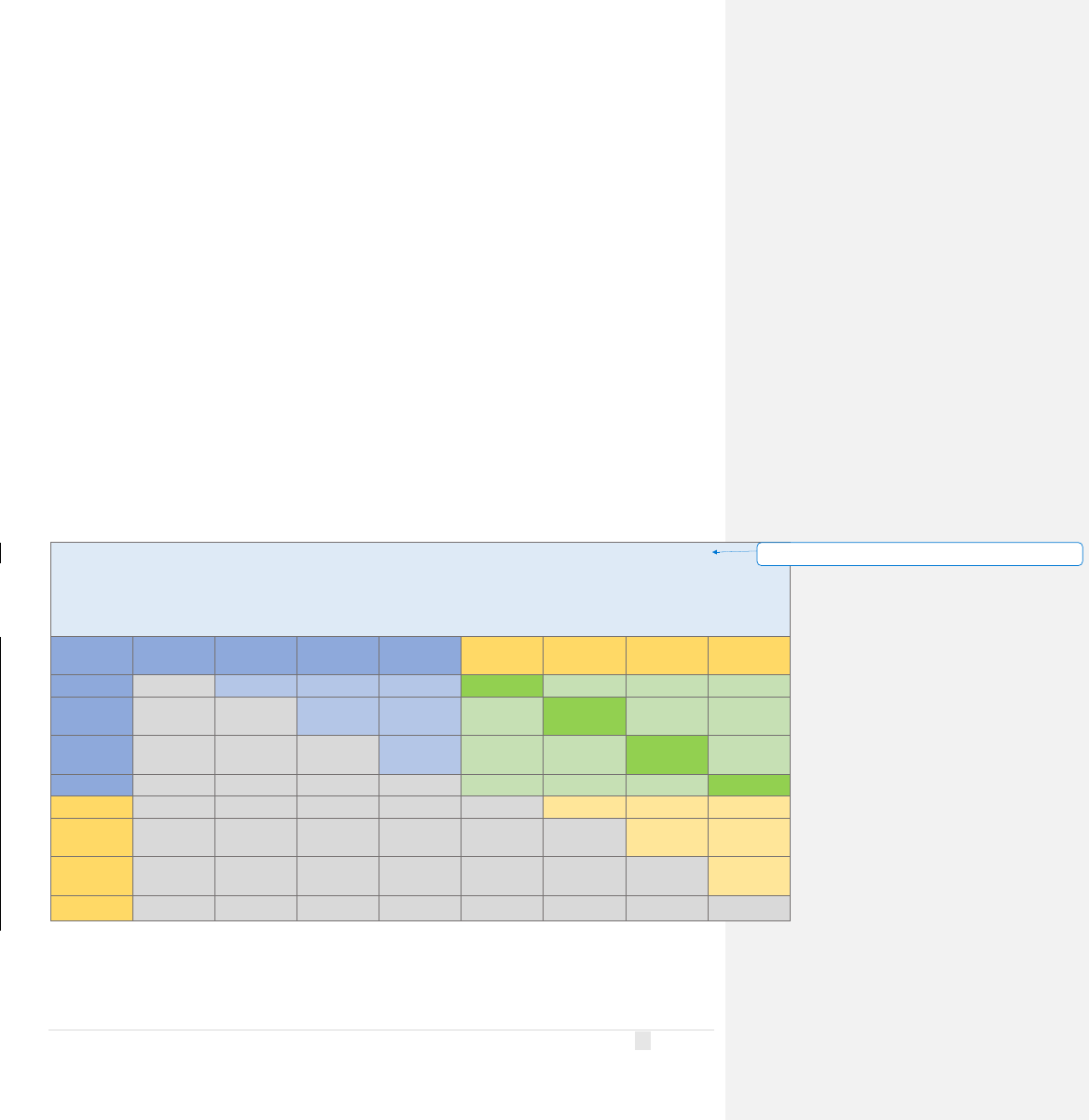
33 | P a g e
Correlations between the Collected Data
Correlations among sensor results further support the hypothesis that black carbon levels are
more affected by distant sources of pollution while the nearby airport is a major factor for
particle count measurements. For this reporting period, as seen in Table 2, one sensor’s
readings for black carbon are highly correlated with black carbon results at the other three
locations, which is expected if the four were in similar locations relative to important pollution
sources. Particle count readings that are not highly correlated between the sensors are
expected when the relative direction of the pollution source(s) differs between sensors. The
finding that black carbon levels are closely correlated at all four locations while particle counts
are less closely correlated reinforces the findings of the interactions between pollution level
and wind direction at the three stations.
There was some correlation between the particle counts at a site and particle counts at the
other three sites and between measurements of black carbon and particle counts. This
association is expected because, except for wind direction, most of the major variables that
would affect pollutant levels will affect levels at all four sites similarly and will affect both black
carbon and particle count levels similarly. Wind speed, traffic levels, and flight operation
intensity are expected to have similar relationships with particle count and black carbon at all
four locations.
Table 2: Spearman correlation of daily air quality results, by site and type. All black carbon sites showed a high
level of correlation (BC-BC, blue) which was not present in either Particle Count – Particle Count (PC-PC, yellow),
Black Carbon – Particle Count (BC-PC, green), or same site combinations (e.g., Fieldview Black Carbon vs. Fieldview
Particle Count, dark green).
Smith BC
Fieldview
BC
Pembroke
BC
Lydick BC
Smith PC
Fieldview
PC
Pembroke
PC
Lydick PC
Smith BC
1
0.942***
0.910***
0.899***
0.426***
0.434***
0.195**
0.603***
Fieldview
BC
---
1
0.878***
0.876***
0.381***
0.421***
0.158***
0.597***
Pembroke
BC
---
---
1
0.877***
0.408***
0.365***
0.383***
0.594***
Lydick BC
---
---
---
1
0.356***
0.371***
0.223***
0.612***
Smith PC
---
---
---
---
1
0.759***
0.387***
0.288***
Fieldview
PC
---
---
---
---
---
1
0.173***
0.255***
Pembroke
PC
---
---
---
---
---
---
1
0.311***
Lydick PC
---
---
---
---
---
---
---
1
* p < 0.05, ** p < 0.01, *** p < 0.001
Formatted Table

34 | P a g e
Comparison to Results from Elsewhere in the State
Particle count data was retrieved from two sampling sites in Providence to provide context for
the results near the airport. One site was located very close to the I-95 and US-6 intersection
(referred to as the Near Road site) and the other at the CCRI Liston campus (referred to as the
CCRI site) in South Providence. The Near Road site operated over the entire period considered
(July 2019-June 2021), while the CCRI site first became operational in November 2019. The CCRI
Liston Site is both south and west of I-95 and west of industrial point sources located at the
Port of Providence. Thus, it is upwind of the largest nearby contributors to pollution levels and
is likely representative of the background levels of black carbon and ultrafine particles in Rhode
Island core cities.
The Near Road site illustrates one of the limitations of this analysis. I-95 runs near to the
airport, with the connector road between them shorter than the lengths of the runways. As the
Near Road sensor demonstrates, highways are a major source of air pollution; however, there
are no highway monitors near the airport, which is a source of confounding that must be
acknowledged. The Near Road values should not be compared directly to airport results, as the
Near Road sensor location is in very close proximity to pollution generation by traffic, not in a
residential neighborhood where people live, and is thus representative of acute exposures for
drivers. Airport sensors aim to quantify the chronic exposures of the surrounding community
and are thus placed adjacent to the receptors, in or near residents’ yards, and not immediately
adjacent to the predicted sources. However, the Near Road site is still a valuable comparison
site as it helps to put the local variability in pollutant levels into perspective.
Both the Near Road and CCRI sites also measure black carbon. The state also monitors black
carbon at two sensors collocated in a trailer behind Myron Francis Elementary School in East
Providence.
As seen in Figure 43, the comparison site black carbon levels follow similar seasonal patterns to
those observed at the airport sensors. The Near Road pollutant measurements are significantly
higher than those observed at other sites, which is consistent with last year’s findings. The CCRI
and East Providence sites had similar seasonal trends and average levels, while the Near Road
site exhibits much more variation, seasonal and otherwise. The average black carbon at the
CCRI and East Providence comparison sites ranged from 347 to 373 ng/m
3
, which was higher
than the average concentrations observed at the airport, where average black carbon levels
ranged from 259 to 334 ng/m
3
.
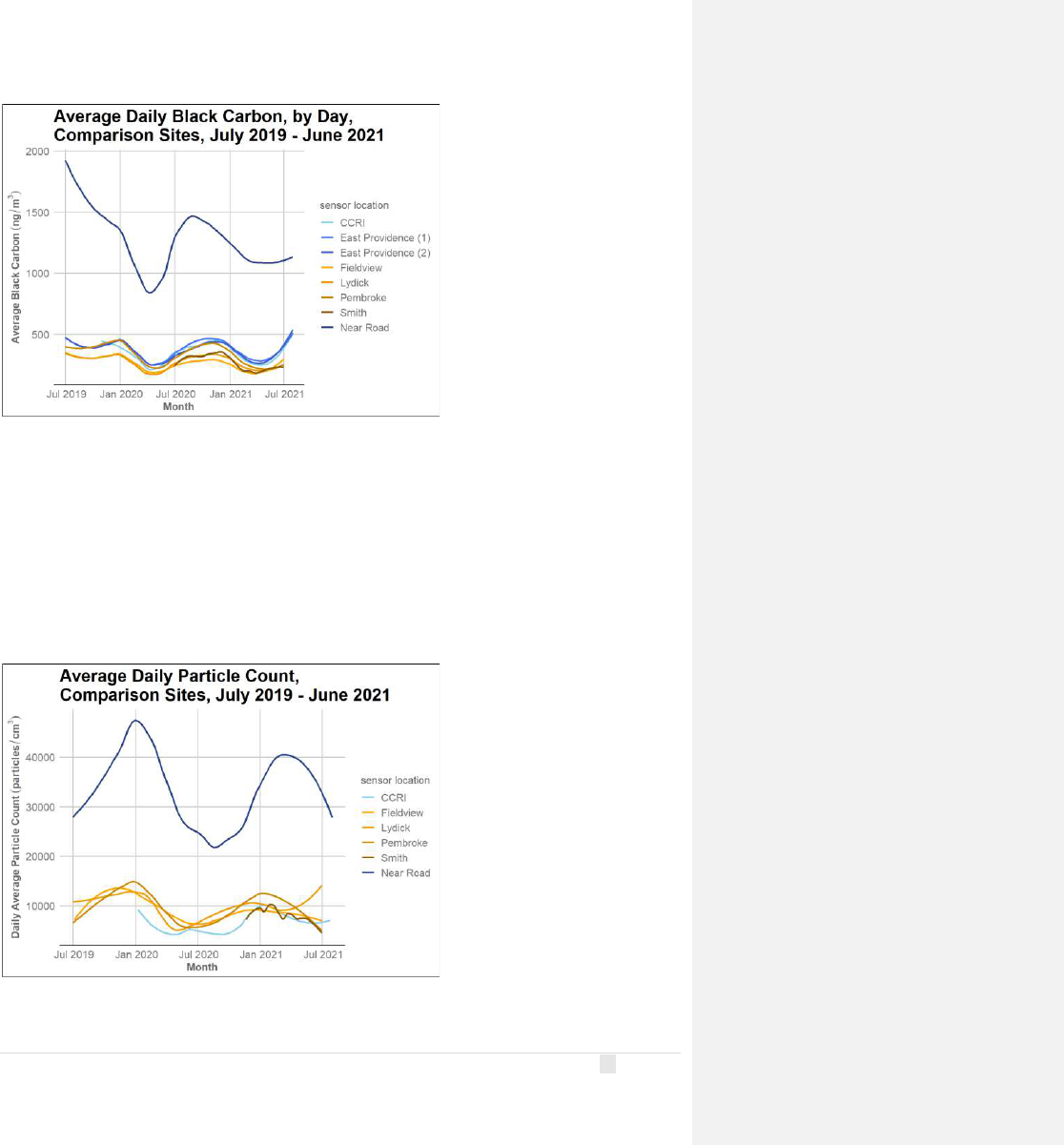
35 | P a g e
Figure 43: Black carbon levels were similar at the East Providence and CCRI sites compared to the airport
sites. Black carbon levels were higher at the Providence sites than the airport sites and significantly
higher at the Near Road site than at other sites.
Like black carbon levels, particle counts were significantly higher at the Near Road site than at
the other Providence sites (Figure 44). The Near Road site also exhibited a greater relative
seasonal variation in particle count than the CCRI site. Unlike black carbon levels, CCRI had
lower average particle count than the airport sensors, with an average value of 6365
particles/cm
3
, as compared to 8058 to 9909 particles/cm
3
near the airport. These observations
are consistent with previous years’ observations and likely relate to the proximity of the sensor
locations to the closest major point source (Figure 45).
Figure 44: Average particle counts at the CCRI site were less than the airport measurements, while the
Near Road site had substantially higher particle counts than any of the other sites.
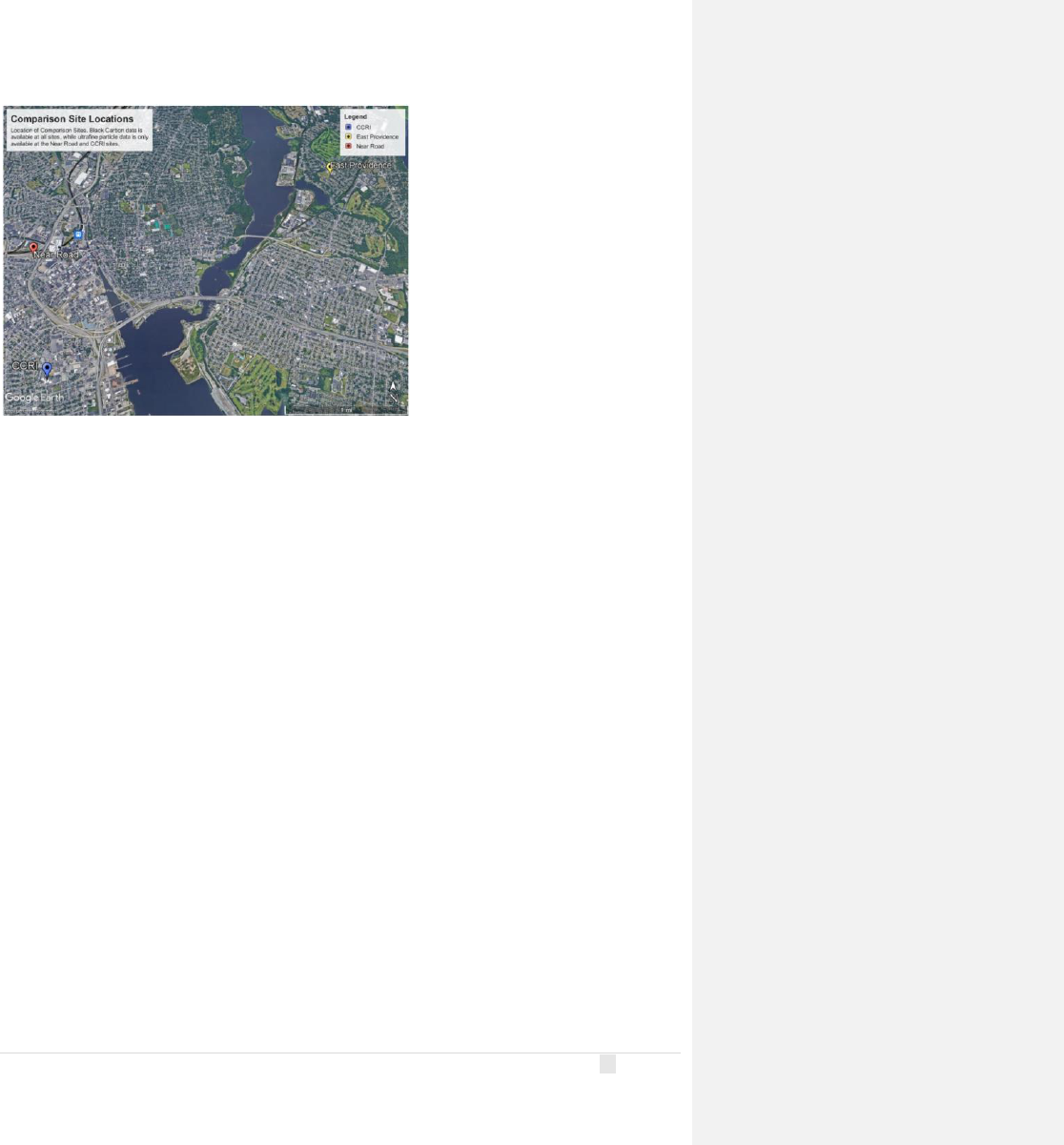
36 | P a g e
Figure 45: Locations of the Near Road, CCRI, and East Providence Locations.

37 | P a g e
Findings and Recommendations
• Most of these data were captured during the COVID-19 pandemic, which may
complicate their interpretation. At the start of the pandemic in Spring 2020, many
pollution-generating activities decreased, resulting in an overall decrease in pollutant
levels. The concurrent drop in flight number and other activities, including automobile
travel, creates a substantial risk of confounding that couldn’t be corrected for with the
available data. Comparison of the pollutant levels observed at the airport monitors to
data on other variables such as traffic or pollutant levels at distant sites may help to
correct for this confounding.
• For the two years of data examined in this report, Lydick had the highest mean particle
count measure of 9909 particles/cm
3
, followed by Pembroke at 9712 particles/cm
3
and
Fieldview at 9137 particles/cm
3
. Smith had the lowest mean value at 8058 particles/cm
3
.
Pembroke recorded the highest average black carbon value of 334 ng/m
3
, followed by
273 ng/m
3
for Smith, 270 ng/m
3
for Lydick, and 259 ng/m
3
for Fieldview.
• Meteorological conditions had significant impacts on both black carbon levels and
particle count; however, some of those results differed between pollutants. For both
pollutants and all sites, windspeed was significantly correlated with decreasing pollutant
levels. Rain also had an impact, as days with no rain had more measured pollution than
those with rain. Heavy rain reduced black carbon more than light rain, but this pattern
was not observed for particle count. Temperature, meanwhile, had a robust negative
correlation with particle count at three of the four sites, which was expected, as cold
weather facilitates particle formation and slows particle aggregation. The fourth
location didn’t have a correlation, possibly due to the confounding relationship between
wind direction and temperature. Black carbon had a positive, weaker correlation with
temperature at two of the four sites.
• Particle counts were higher when wind directions were from the airport to a given
sensor and lower when the wind blew towards the airport, which is expected if the
airport is a major source of ultrafine particles. This was expected because the locations
of the sensors were selected to measure the impact of the airport, and thus they are
much closer to the airport than to other large sources. Ultrafine particles do not travel
long distances before accumulating into larger particles, so more distant sources affect
particle mass (PM
2.5
) much more than the particle count measured here.
• The four black carbon sensors responded similarly to wind direction, rather than in a
manner dependent on their position relative to the airport, which suggests black carbon
may be primarily influenced by more remote sources.
• For both particle count and black carbon, peaks were observed around 6 a.m. and 8
p.m., consistent with the previous report’s observations, with lower values in midday
and early morning. This trend was also observed in previous reports, where it was
hypothesized that the morning peak was due to work commuting while the afternoon
dip may be due to trends in wind speed. However, there were significant differences

38 | P a g e
between the daily trends for black carbon and particle count. For black carbon, the
timewise trends were highly consistent between sensors, while there was much more
variability observed between the trends for particle count by sensor. Additionally,
particle count did not exhibit as much of an afternoon dip, and a small midday “peak” is
observed in the Fieldview and Smith sites. This pattern is consistent with the airport
activities impacting particle count more than black carbon, since there were more flights
during midday than other times.
• In this report, we also examined the results from select urban comparison locations to
provide context for the observations. Black carbon was measured at Myron Francis
Elementary (known as East Providence), CCRI Liston Campus, and at the Near Road site,
while particle count was measured at CCRI Liston and at the Near Road site. At both the
CCRI Liston and East Providence sites, black carbon levels were higher than the airport
sites. At the CCRI site particle counts were lower than the airport (the Myron Francis
Elementary site does not measure particle count). Seasonal trends in pollutant levels
were similar at the comparison sites to the airport sites.
• For both pollutants, the levels measured at the Near Road site greatly exceeded the
levels at the airport. These results should not be directly compared, as the Near Road
site was located immediately adjacent to the pollution source to monitor levels that
people are likely to encounter in their cars, while the airport monitors are further from
the potential sources to measure levels people encounter near their homes.
Nonetheless, it is important to highlight these findings as traffic on I-95 is a source of
confounding due to the pollution generated by traffic and the Near Road results might
be helpful for controlling for confounding in a future analysis.
• The findings relating to wind direction suggest that the airport is one of, if not the,
primary sources of ultrafine particles at these stations, as all four sensors detected
particle counts approximately three times higher when the stations were downwind of
the airport than when they were upwind. It also suggests that much of the black carbon
detected comes from a source other than the airport. These observations are consistent
with the properties of the pollutants; ultrafine particles disperse rapidly through both
distance and time, while black carbon can have a much longer retention time, allowing
detection of pollution originating from further sources.
• Given the consistent findings across multiple years, the conditions that lead to higher
levels of local air pollution around the airport are relatively well established. This
monitoring program has improved our understanding of how meteorological and human
activity-associated variables affect pollution in the neighborhoods around an airport.
• The data gathered here can be used to attempt to correlate the daily pollution data to
health outcomes, adding to our body of knowledge about these pollutants. RIDOH has
access to health data such as emergency department visits for asthma or cardiovascular
disease that could be analyzed in conjunction with the pollutant levels in a future
analysis.

39 | P a g e
• At this time, the sensors appear to be performing within the specifications required by
the Act. Smith was the last location to start producing consistently reliable data, in
November of 2020. If the sensors continue to perform consistently through July 31,
2023, the requirements of the Act will be fulfilled.
